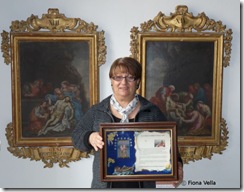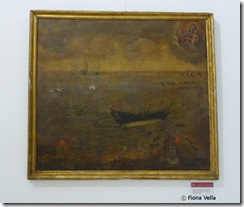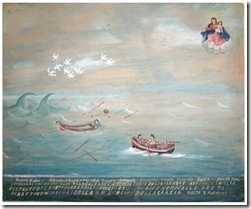Posts Tagged ‘Malta’
-
Love in the time of war
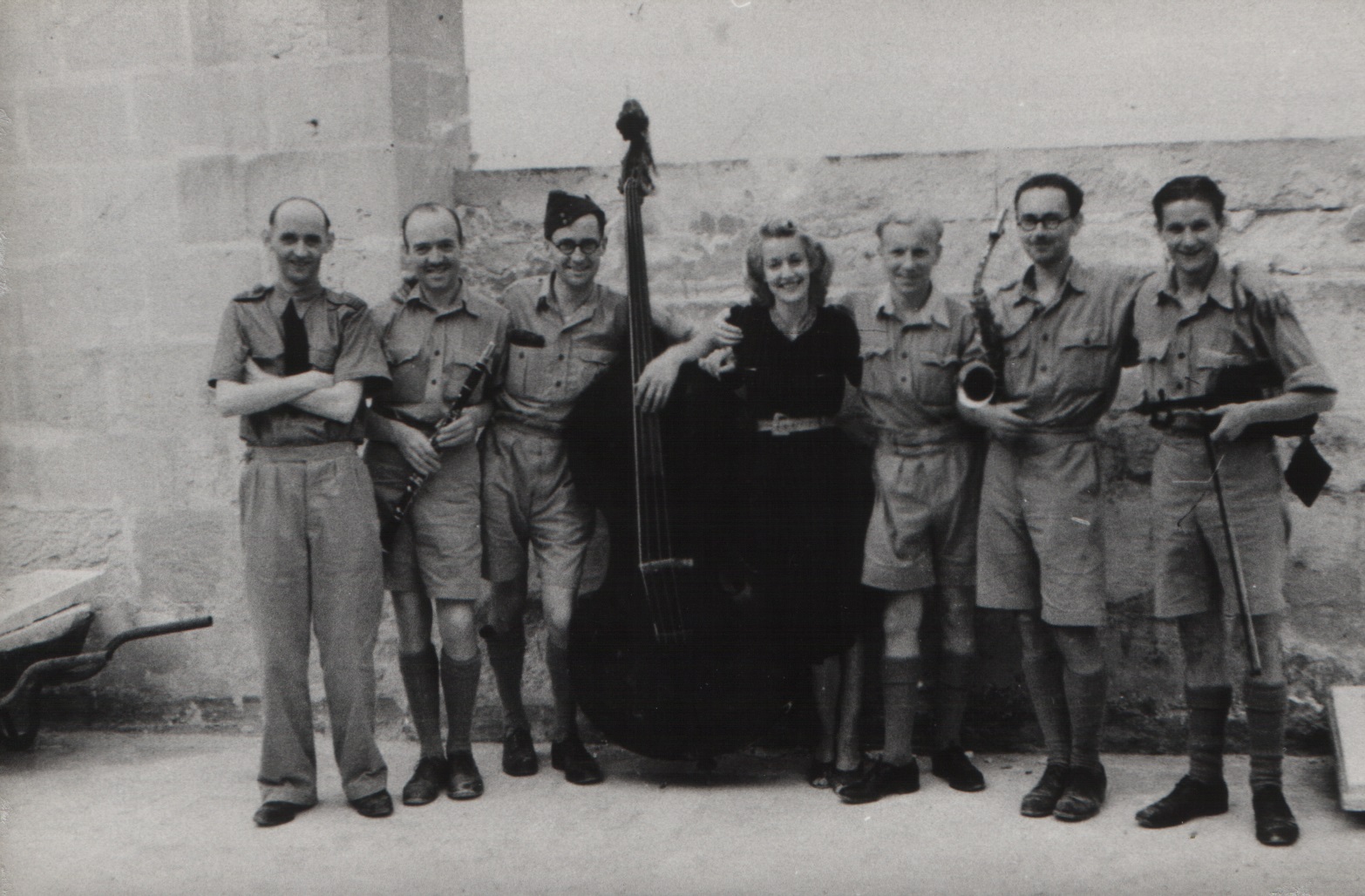
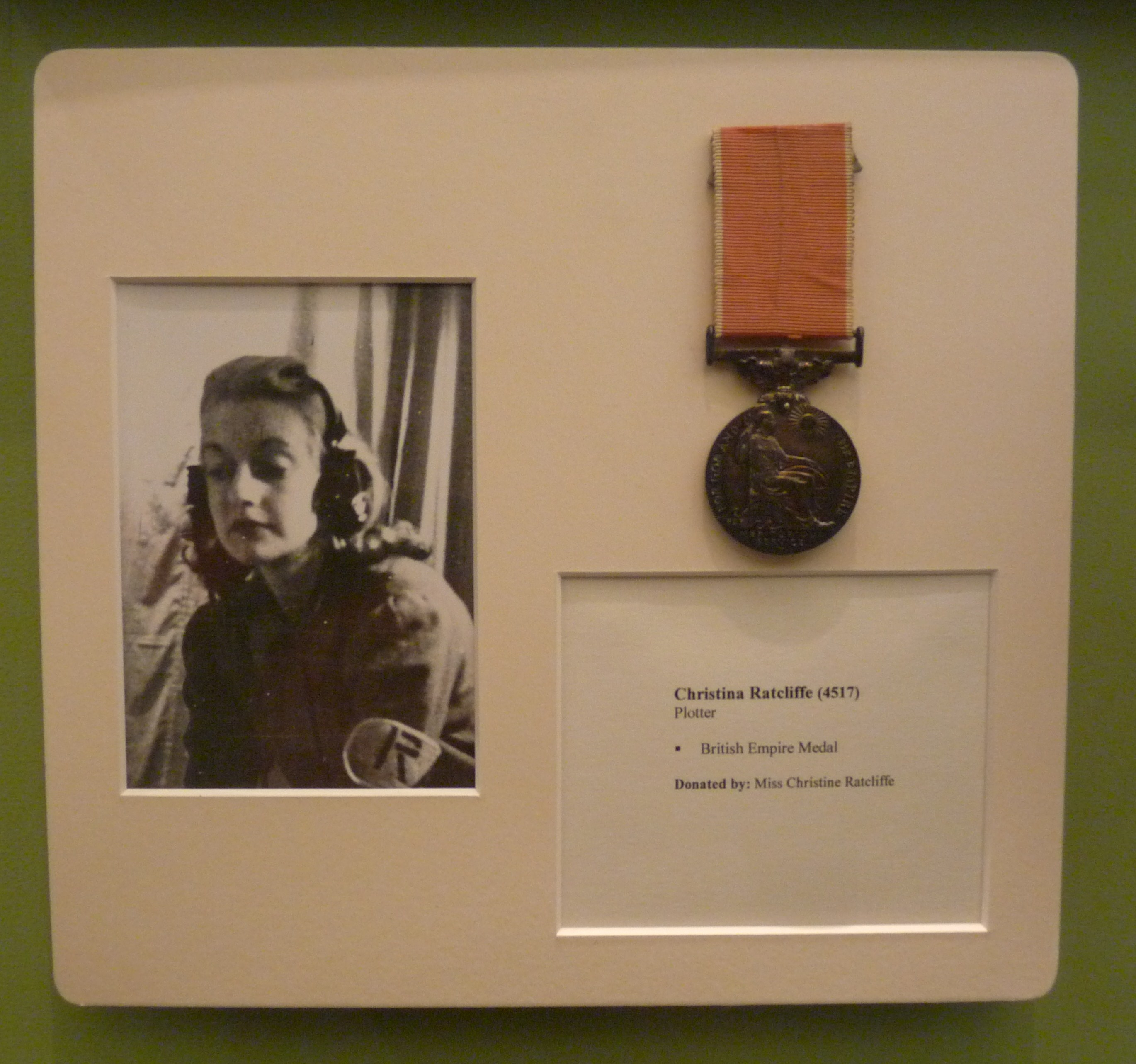
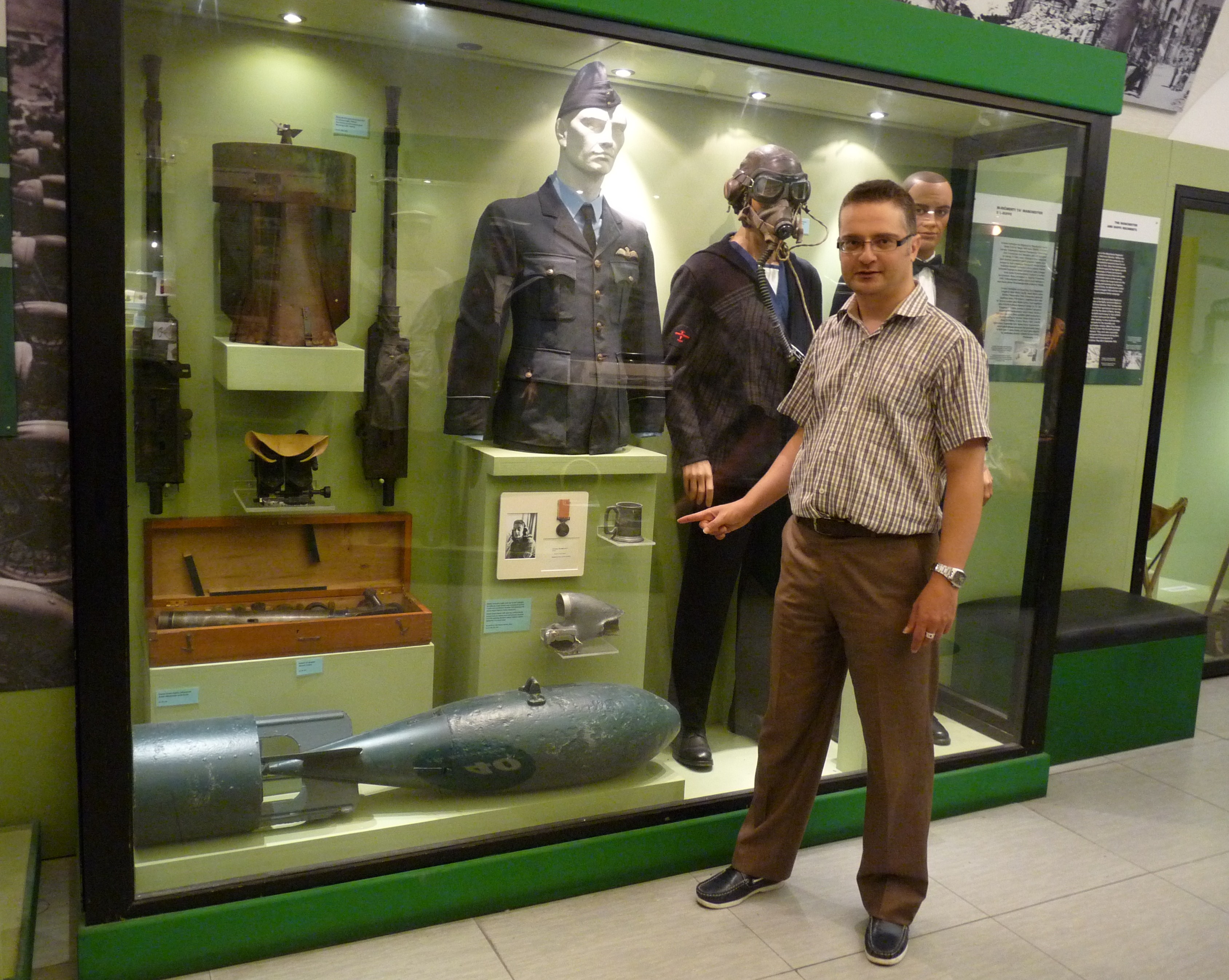
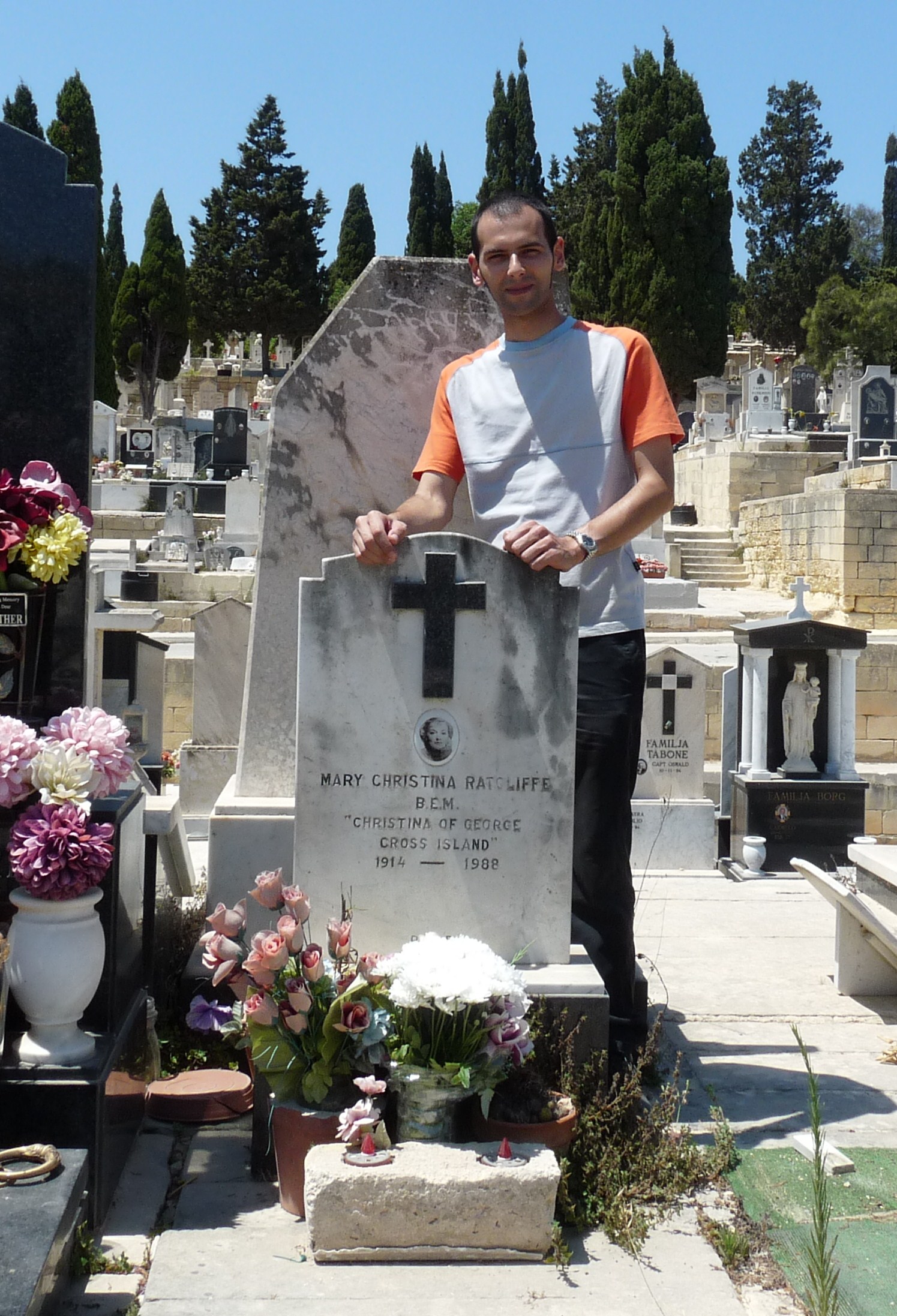
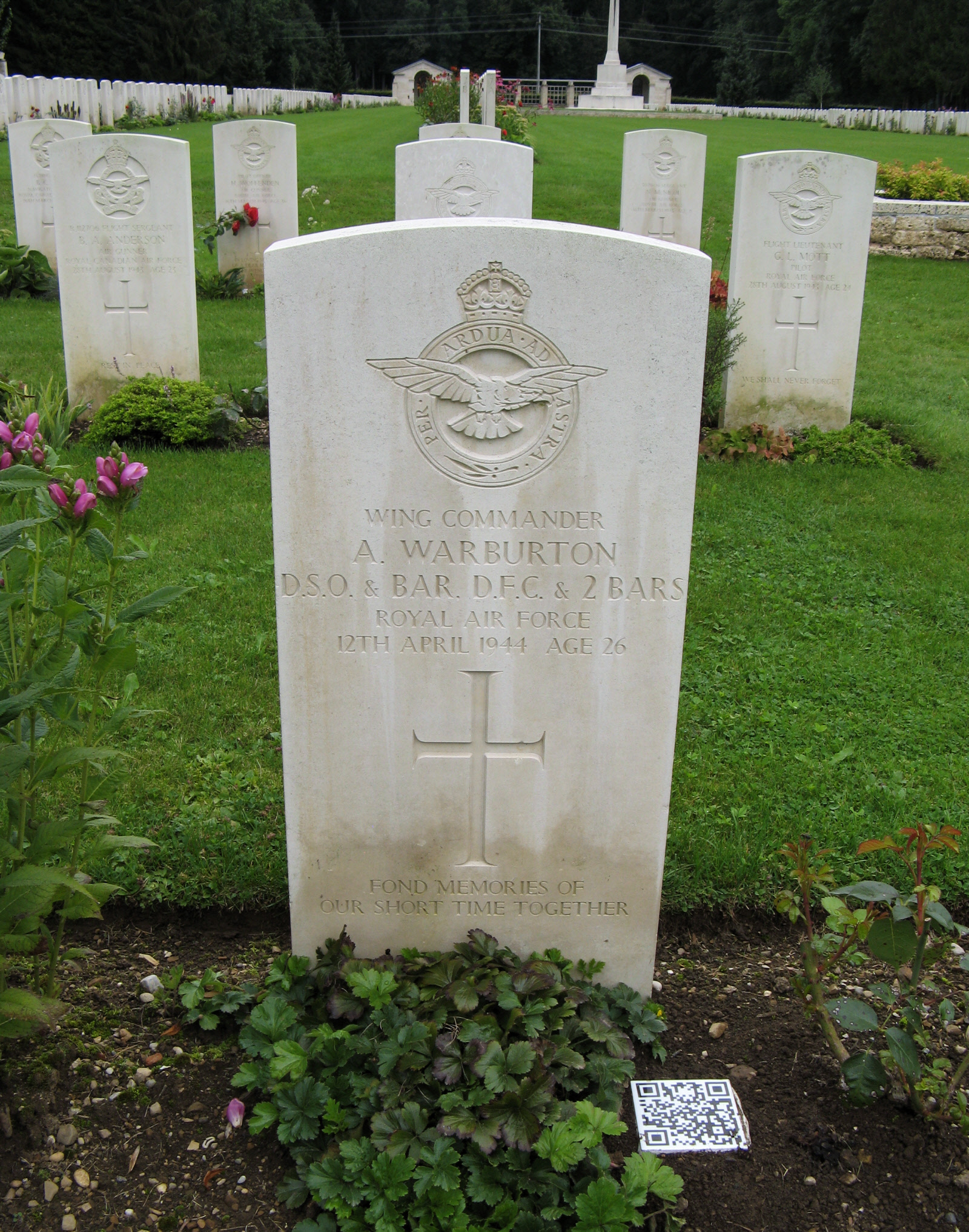
A century ago, many countries had to deal with the onset of World War I which was supposed to be the war to end all wars. Yet, a few years later, the reality of World War II ravaged again many people’s lives, as it devastated their motherland, their homes and their existence.
Today, these poignant episodes are recorded in various museums around the world, including the National War Museum in Valletta, wherein one finds several objects which recall these dark periods. However a visit to this museum will reveal that its exhibits are witness to more than that, since they also display how people confronted and survived these crucial moments, and how the ugliness of war never stopped their urge to live and to love.
During a recent visit to this museum wherein I was accompanied by Curator Charles Debono, I discovered how five particular items – a British Empire Medal, an RAF side cap, a uniform jacket, a tankard won at a sports event, and part of a manifold of a P38 Lightning aircraft – formed part of a fantastic narrative relating to a famous English couple who met in Malta and were united and separated by war. Indeed, as I followed the story of the legendary Wg Cdr Adrian Warburton and his lover Christina Ratcliffe, I was whirled back in the 1940s; a time when both the Maltese islands and their inhabitants were pushed to their limits and heroes were borne.
Adrian Warburton was born in Middlesborough on March, 10, 1918, but his father Geoffrey, a young submarine commander who had been awarded the prestigious Distinguished Service Order, decided to christen him in a submarine which was berthed in Malta. Apparently, a good number of Warburton’s family members were renowned for their eccentric behaviour, particularly where war was concerned, and as Tony Spooner said in his book Warburton’s War, “DSO’s were fairly commonplace in the family”.
In fact, during his brief life, even Adrian received this honour twice: one of which was awarded to him for his bravery when flying very low among the Italian battleships and cruisers in Taranto in order to read their names, after the cameras failed to work during a reconnaissance mission. This information enabled the Fleet Air Arm to dispatch an effective attack on the enemy later on that night.
Interestingly, during his training to become a pilot, Adrian had failed to impress his seniors and even though he eventually succeeded to pass his trials, his general assessment was deemed below average. Probably, besides his dare-devil acts, this was also the reason why he crashed his planes during some of his missions. Presumably, this was also the motive for the disbelief that he was dead, after he went missing during his last flight in 1944 …It was on September, 6, 1940 that Warburton arrived in Luqa airfield after he was transferred on duty to Malta. Soon he distinguished himself for his fearless attitude such as when he and his two crewmen shot down an Italian Z.506B seaplane when they were only expected to shoot some photos.
His love story with Christina Ratcliffe took place after she was stranded in Malta, when Italy declared war on Britain and France on 10th June 1940. She had come to our islands together with her group in order to perform as a cabaret dancer but when they found themselves unemployed, these artists set up an ensemble which they called the Whizz Bangs and provided entertainment for the troops.
During her stay on the island, Ratcliffe made friends with a French pilot, Jacques Mehouas, who often spoke to her about Warburton and described him as a brave and formidable British pilot. Ironically, it was his death which brought them together, when Warburton, who was also a friend of his, approached her to give her his condolences. Ratcliffe considered this first encounter as love at first sight since in her later writings she admitted that with his golden hair and his beautiful blue eyes, Warburton resembled a Greek god.
In 1939 Warburton had married Eileen Mitchell after a very brief courtship but allegedly he had left her at once when he found out that she was divorced and had a child. However in Ratcliffe, he discovered a soul mate and soon they became one of the most renowned couples at the time. Like the British pilot, she was beautiful, charismatic and adventurous and as Spooner described them “With their personalities, zest and determination, they were to become living symbols of the island’s unconquerable spirit.”
In fact, besides working as an entertainer, after some time, Christina volunteered to work with the RAF as a telephonist and later as a plotter at the underground War Headquarters in Valletta. She was eventually appointed Captain of D Watch and then became assistant to the Controller, thus having to abandon the Whizz Bangs group.
This love story came to an abrupt end when on April 12, 1944, Warburton was sent on a reconnaissance mission during which he was supposed to take some photos over Germany, but he never returned. At first his disappearance was not given much importance because workmates, friends and even Ratcliffe were expecting him to return like he always did before. Yet by time, this matter became riddled with speculation as people started to question whether he had committed suicide or whether he had simply left his girlfriend and started a new affair.
After this incident, Ratcliffe changed drastically. Her neighbours recall that she became a recluse, preferring to live in isolation in her apartment at 7/3, Vilhena Terrace, Vilhena Street, Floriana, and forever waiting for her Warby to return to her. In his book Women of Malta, Frederick R Galea, states that “her last few years were unhappy ones, trying to drown her loneliness in alcohol; she became withdrawn and impoverished.” Certainly this was a pitiful end to a woman who in 1943 was awarded the British Empire Medal in recognition of her work during World War II. During her lifetime, Ratcliffe donated this medal together with the uniform and the tankard which belonged to her beloved Warburton, to the National War Museum in Valletta.
It was finally in 2002 when Warburton’s fate was identified, after Frank Dorber, a Welsh aviation researcher, discovered his remains in the cockpit of his wrecked plane, buried about two metres deep in a field near the Bavarian village of Egling an der Paar, 34 miles west of Munich. An examination of his aircraft showed that one of the propellers had bullet holes in it, thus indicating that Warburton had been shot down. Part of this plane was donated to the National War Museum in Valletta and now forms part of the exhibits which reflect this story.
Meanwhile, according to Commonwealth regulations, Warburton was given a formal funeral on May 14, 2003 and he was buried at the Durnbach Commonwealth War Cemetery. Curiously, this ceremony was attended also by his wife Eileen whom many believed to have been dead. After Warburton was found and buried, many sympathizers of the couple Warburton – Ratcliffe demanded whether it was time for these two lovers to be re-united, even if after death? But where is Ratcliffe?
A visit to the Addolorata cemetery in Paola where I was accompanied by Eman Bonnici, who is the cemetery’s assistant librarian and a researcher of this site, led me to the resting place of ‘Christina of George Cross Island’. He explained to me that the cemetery’s records show that Ratcliffe was originally buried in the common area of the Commonwealth section in 1988. According to a grave-digger from Floriana, Ratcliffe had become so poor that the neighbours had collected the necessary funds to provide her with a proper burial. Then, in 1991, an individual bearing the surname Ratcliffe, bought a grave for her so that her remains will not be lost in the common ossuary. This grave, marked no. 4, is situated in the East Division, Section MA-D. Bonnici informed me that Ratcliffe’s grave is regularly visited by foreigners, particularly from England and Scotland, who come to this cemetery in order to pay their tribute to a heroine of such a turbulent but fascinating love affair.
(This article was published in ‘Man Matters’ Supplement in The Times of Malta dated 20th September 2014)
-
With a salutation

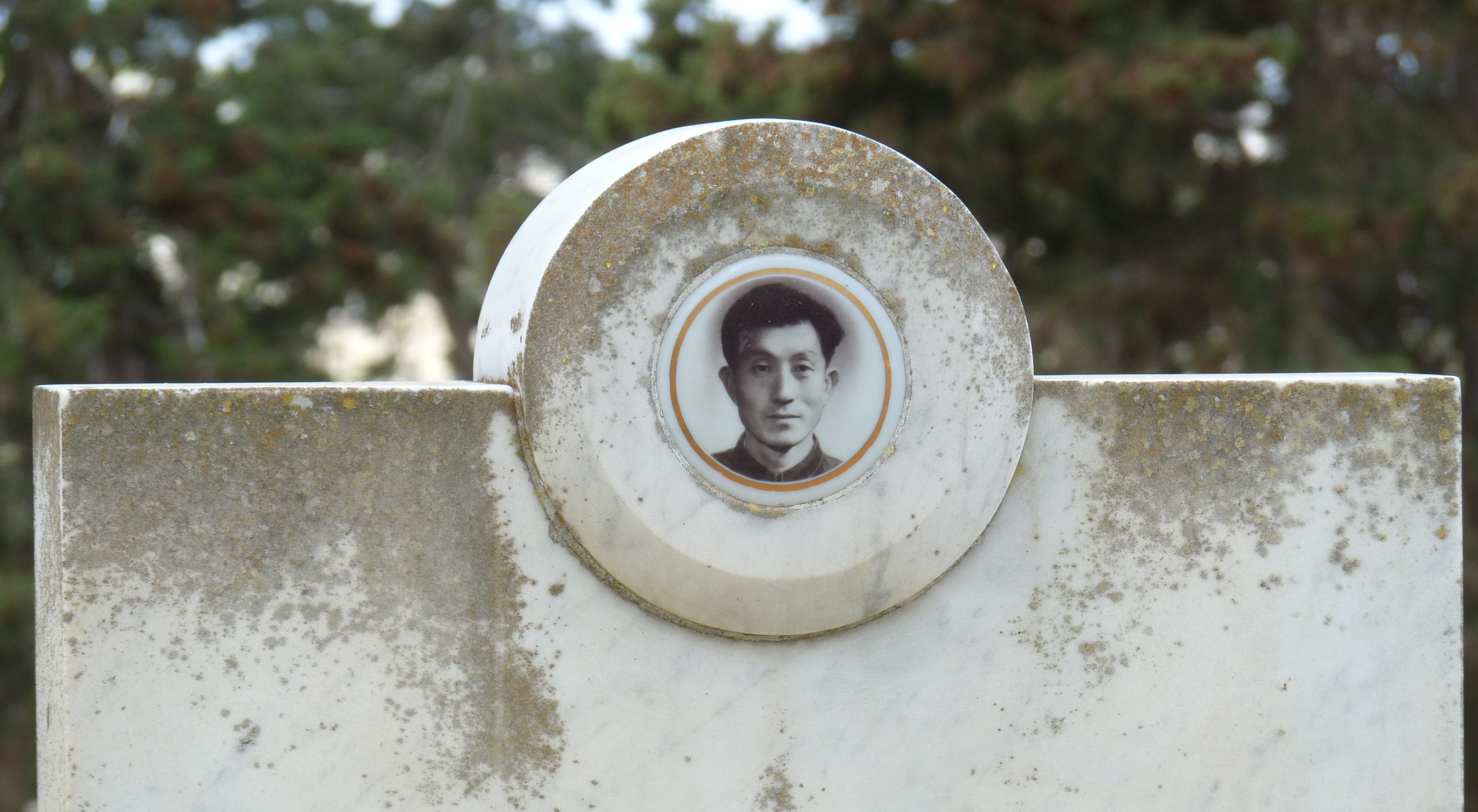
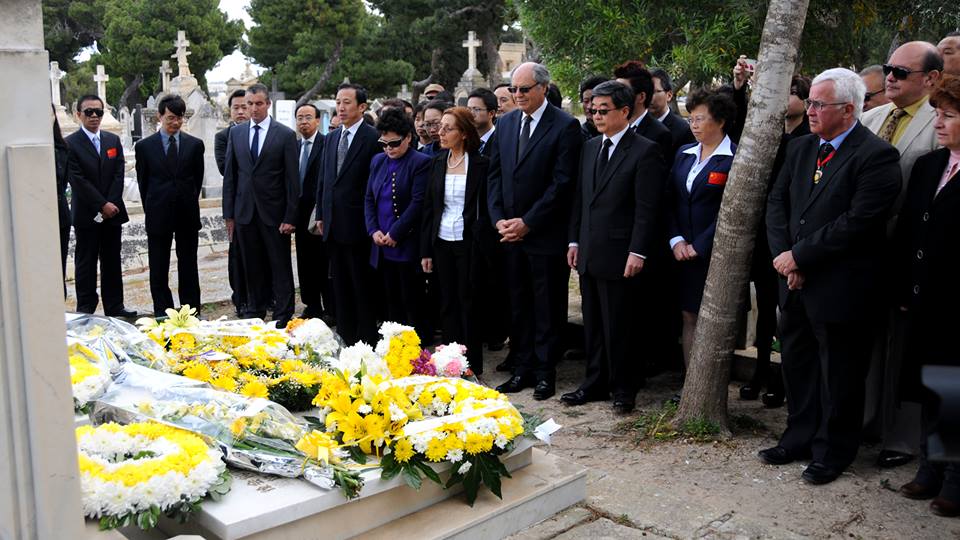
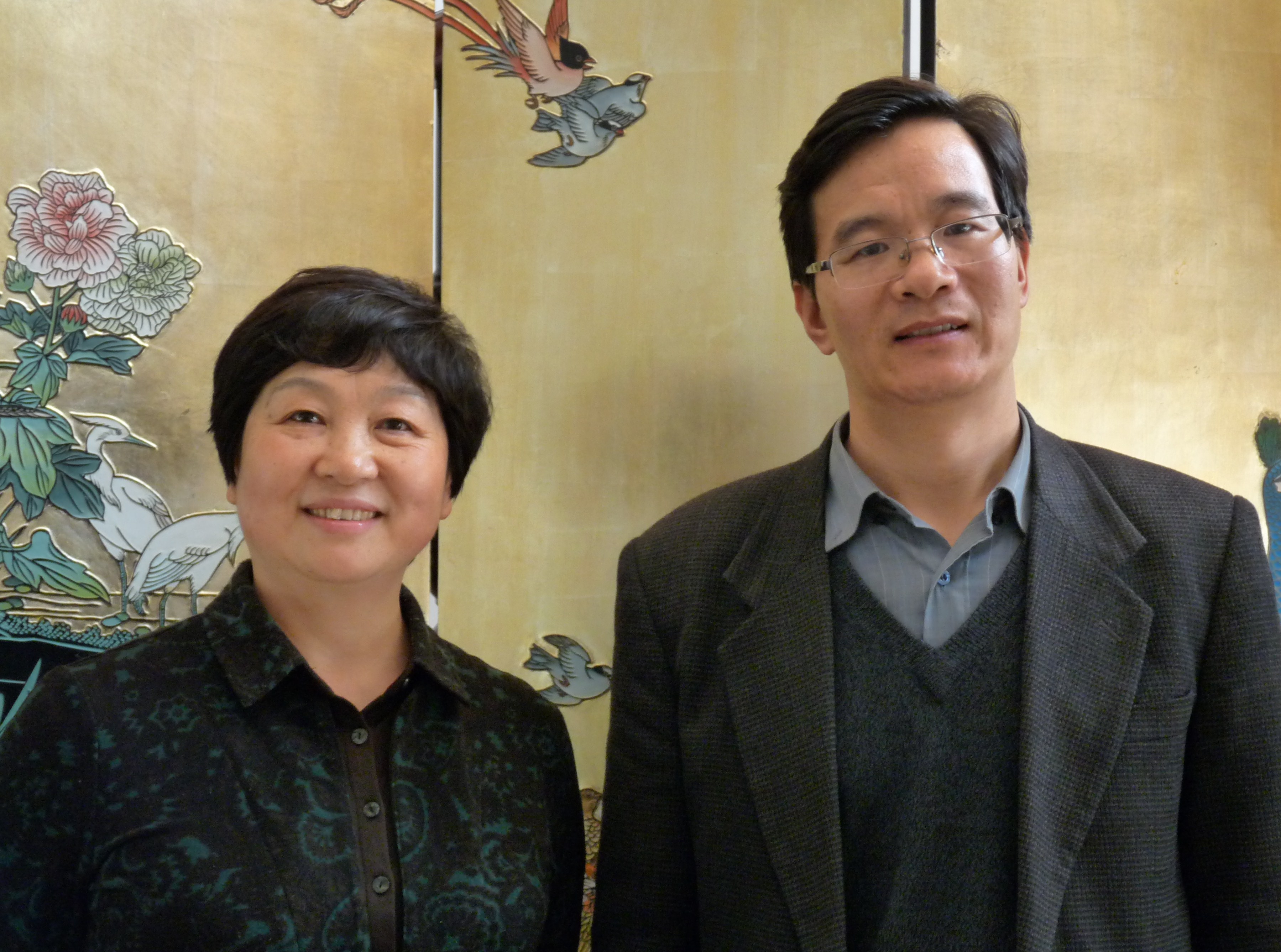
On 5th April 2014, representatives from the Embassy of the People’s Republic of China in Malta and a number of Chinese persons, together with some Maltese individuals, including Malta Minister of Finance, Edward Scicluna, Mayor of Santa Luċija, Frederick Cutajar, and members of the Malta-China Friendship Society, attended to a ceremony in respect of two Chinese workers who died in our country in 1979.
These two workers formed part of a group of hundreds of Chinese workers who were sent by the Chinese government in order to assist Malta in the construction of Dock Number 6 or as it is popularly known as the Red China Dock. This took place according to an agreement between China and Malta in the 1970s, wherein China agreed to help our islands in order to strengthen our economy.
The two Chinese workers who lost their life in Malta
Unfortunately, Xu Huizhong, a Chinese engineer aged 47, lost his life tragically on the 16th March 1979 whilst he was assisting in the construction of the dock. He was honoured with the Medal of Honour of the Republic of Malta on the 23rd April 1979. On the other hand, engineer Gu Yanzhao, died of natural causes at the age of 46.
These two Chinese workers were buried in Malta according to their relatives’ decision since in Chinese culture, it is believed that in order to rest in peace, these individuals had to be present on the same land when the project on which they were working was successfully finished. Moreover, they believed that in this way, they would continue to be remembered with respect by the Maltese people.
In the words of Minister Scicluna, “There is no higher sign of friendship than to give your life in order to help another country.” And now that with these articles, I am getting much fonder of China and its people, I could not allow myself not to investigate more this story and all the narrative that I knew that I would discover…
The ancient tradition of the Qingming Festival
I started my exploration by visiting the tomb of these two Chinese workers which is located at the Addolorata cemetery. I took with me a colourful bunch of flowers as a sign of respect and love. However, when I arrived in front of these tombs, I realized that I had met another Chinese cultural aspect as unlike my bunch, all the flowers that were left on these tombs after the ceremony, were white and yellow. As soon as I returned home, I researched about this and I learnt that this was part of the ancient Chinese tradition known as Qingming Festival.
In order to help me to understand better this concept, this week, I met Qiu Guangling and her assistant, Shi Qidong, at the Embassy of the People’s Republic of China in Malta. They informed me that this festival formed part of the 24 aspects of the Chinese lunar calendar wherein among the various celebrations, people celebrate the beginning of the Spring season and the rememberance of their dead ancestors. Some refer to this festival as Pure Brightness Day or Tomb-Sweeping Festival and this generally takes place around the 5th April.
The legend of Jie Zitui
Often, the Qingming Festival is associated with Jie Zitui who during the 7th century B.C. lived in the province of Shanxi. It is said that he was one of the few officials who followed Chong Er, the son of the Duke of Jin, when he had to leave due to severe restlessness in his country.
Chong Er lived for 19 years in exile and his situation became so miserable that eventually everyone abandoned him, except for five individuals, including Jie Zitui. This official respected his leader so much that when Chong Er was dying of hunger, he cut a piece from his thigh and cooked it for him so that he could get back his strength.
Finally, there came a time when Chong Er succeeded to win back his deserved throne and he returned to Jin as a leader. Together with him, he took those loyal officials who had remained with him through the worst time and he gave them the title of noblemen. Yet for some reason, Chong Er forgot Jie Zitui who now was an invalid due to the personal sacrifice that he had done for his master.
Nonetheless, when Chong Er realized his mistake, he immediately went to Mian mountain in order to find Jie Zitui who had gone to live there with his mother. But Jie Zitui had discovered serenity in this natural refuge of the mountain environment and he did not want to leave it to return to the city. Therefore, although he was aware that Chong Er was looking for him, he remained hidden with the hope that his friend will eventually give up and leave him alone.
Yet this did not take place, for Chong Er was so resilient to find him that he decided to set the mountain forest on fire in order to force his friend out of his hideout. The huge fire which was lit continued to burn for three days until all the mountain was burnt out. Alas, when the people of Chong Er went in to look for Jie Zitui, they found him burnt together with his mother.At these terrible news, Chong Er fell into miserable grief for what he had done and out of respect towards these two persons, he buried them at the foot of Mount Mian and changed its name to Jie. Moreover, he built a temple on it in honour of their memory.
In order to remember this tragedy, he ordered that each year in those particular three days, nobody could light a fire in his house and only cold food could be eaten. This started the Hanshi or the Cold Food Festival.
Then, around 300 years ago, during the Qing Dynasty, this festival was incorporated witin the Qingming Festival and this event was changed into a celebration of rememberance and sacrifice for the ancestors. Nowadays, the Cold Food Festival is celebrated a day before the Qingming and the activities continue for three whole days.
Just like we do in November, when we visit our cemeteries in order to show respect towards our dead relatives, in China these activities take place in April. Indeed, during this festival, a lot of Chinese people gather into cemeteries wherein they clean the tombs, repaint the calligraphy on them, burn incense and leave white and yellow chrysanthemums which in Chinese culture symbolize sadness and grief. Furthermore, they offer food and drink to their dead, and relatives meet on the tombs or in the surrounding gardens in order to eat together.
Yin House Feng Shui
It is interesting to know that when one is choosing a place for burial in China, usually, Feng Shui experts are called according to an ancient tradition. The main aim of Yin House Feng Shui is to choose the correct site for burial so that the energy of the dead is turned into a positive one in order to bring luck to their families. In fact, Chinese people believe that if the dead are not allowed to rest in peace in a place which guarantees their serenity, their living relatives would incur dire consequences.
The Imperial Tombs of China
This principle regarding tombs originated when man created the concept of a soul and therefore introduced also the idea of a life after death. Therefore, along the years we can observe various transitions in tombs which serve as a mirror of the ideas of the society which made them. In fact, as time passed, we can notice that tombs became more refined until in the period of the greatest dynasties, the imperial tombs took the shape of whole temples in the belief that the leader could continue to enjoy the same beautiful environment that he was used to during his life even after death.
The Mausoleum of Emperor Qin Shi Huang
This mausoleum was constructed by the Emperor Qin Shi Huang in the 3rd century B.C. in order to serve as his tomb. This enormous building was one of the first structures which were built for this reason, wherein the surrounding environment was chosen appositely in order to offer the right ambience to the emperor after his death.
According to ancient writers, originally, this mausoleum was around 120 metres high and its base was 2167 square metres. Many trees and plants were sown in the area in order to embellish the zone. A dike that was 10 metres high and 1400 metres wide was constructed to avoid inundation of the territory from the nearby rivers. Moreover, the course of the river that passed through the south of the mausoleum was altered and its new route led to Weihe river so that its waters would not be an obstacle.
It is estimated that around 12.8 million cube metres of earth were used in order to build the foundation of the emperor’s tomb and those of nearby tombs in the same site, together with the construction of the dike and the manufacturing of the statues that were made to adorn the place. Meanwhile, a further 1.2 million cubic metres of earth were required to fabricate the emperor’s tomb. It is interesting to note that all this stone was cut from the quarries of Mount Ganquan which was located 200 km away from the site of this mausoleum!
In the meantime, Emperor Qin Shi Huang ordered to put priceless artistic works of great skill in his tomb, including jewels made of gold and silver, artworks, writings, clothing and many more accessories. Finally, there was so much wealth in this mausoleum that it was too difficult to calculate how much time, work, material, money and lives it came to cost. Yet certainly, once the emperor died, he buried everything with him and without knowing, he conserved some of the best cultural treasures which were to be enjoyed by later generations.
However, the emperor wanted more than this as an accompaniment to his voyage after death. In fact, in order to build this tomb, apart from the best tradesmen who were selected, its construction which involved many years, was done my many criminals, by farmers who had not paid the taxes and by slaves. Besides the emperor’s tomb, these were ordered to build another tomb that was located around 1400 metres away and finally all the criminals were buried in it once the emperor was dead. In fact, during archaeological excavations, an area of 1200 metre squared of human bones was unearthed.
Ironically, though the emperor was preparing such a fantastic place for himself after death, he was terrified of death and he dedicated many years in search of the elixir of life in order to acquire the font of eternity. Since he was a cruel tyrant, there were several attempts on his life but he always succeeded to avoid getting killed. Until eventually luck left him when during one of his voyages, he swallowed some mercury pills which were supposed to prolong his life!
Ultimately, Emperor Qin Shi Huang was so much hated by the people, that his dynasty ended soon after his death and his tomb was robbed and burnt more than once. Yet this mausoleum was so huge that in 1974, whilst some Chinese farmers were digging to construct a well, they came upon another part of this site which was still intact and everyone was surprised.
A group of archaeologists was called in order to excavate this place and among the enormous and unique discoveries, they found also a whole army of terracotta soldiers which were accompanied by horses with carriages of actual size. Hundreds of such soldiers were found and each of them had individual faces with different characteristics. However, it is believed that there are around 8000 soldiers in all to be unearthed. Moreover, it seems that there are also 130 carriages with 520 horses, and 150 cavalry horses buried in this mausoleum.
Each year, this discovery attracts thousands of tourists to this site and when some of these artifacts are exhibited in other countries, many people go to visit them. This fact was confirmed also by the Senior Curator of the Malta National Museum of Archaeology, Sharon Sultana, when in 2007 an exhibition with 81 artifacts from the mausoleum of Qin Shi Huang, consisting of 10 terracotta soldiers and 2 horses were displayed in this museum.
Other traditions related to Qingming Festival
Since this festival takes place during the beginning of Spring, this is the time when farmers start to plough and sow their fields. This is also a period when many beautiful flowers enhance the Chinese landscape and so part of these celebrations include also walks in the splendid countryside. These days offer also particular moments for young people to meet and many new love stories begin at this time. As a cheerful greeting to this new season, the sky is filled with numerous kites that are made with great skill and in various forms and so these days are also enriched with beautiful and positive memories.
(This is a translation of an original article which was published in Maltese in the series PONT MAĊ-ĊINA (5th Part) in the newspaper Torċa dated 20th April 2014)
-
Keeping the faith: ex-voto paintings
In the old days, the sea played a prominent role in peoples’ lives, especially to island inhabitants. It was a source of livelihood for fishermen, a fortuitous space for pirates, a bridge to other countries for travellers, merchants and diplomats, and a channel for soldiers from which to attack the enemy during war.
People were often moving on the sea on various types of vessels, constantly aware of the risk that this involved. They feared corsair attacks and the aggression of unknown dangerous species which could lurk in the waters’ depths. Yet none was worse than the actual possibility of experiencing a terrible storm where the sea turned into a formidable voracious colossus which could engulf whatever dared to be present during its deadly rage.
Meanwhile, it was a world where people in jeopardy were generally left to deal with their own fate, and ironically it was often faith which led to their survival. Historical sources describe how people created ingenious ways of dealing with these dangers by formulating different methods to guarantee a safer voyage, habitually intermingling religion with superstition. One of these practices in Malta involved the production of sacred coins which could be thrown into the sea to calm down the troubled waters. Indeed, sailors were urged to buy these coins which were made out of blessed white candle, a day before Easter, since failure to do so was believed to attract dreadful bad luck. On the other hand, local fishermen are known to have concocted a secret prayer which only the eldest of them knew and which only they could recite in order to shield their boat against the threat of bad weather.
Although hundreds of years have passed from these experiences, nowadays we still have the opportunity to witness the ordeal that our ancestors have gone through whilst being out at sea. Many of these testimonies are still present among us in the form of ex-voto paintings wherein devoted people have illustrated the eventful moments when they were about to die and their faith saved them. Sadly, though we have lost many of these ex-voto along the years, mainly due to improper storage and conservation methods, we still find various examples in numerous chapels, churches, sanctuaries and museums around our islands. Among these, one finds 183 maritime ex-voto in the sanctuary of Our Lady of Tal-Ħerba in Birkirkara, and another 64 in the sanctuary of Our Lady in Mellieħa.
Another interesting collection of such ex-voto is located in the Żabbar Sanctuary Museum. Unfortunately, from the original assortment of 300 maritime ex-voto, today only 85 remain. However, as Ġużeppi Theuma, the Secretary of the Żabbar Sanctuary Museum Commission has informed me, this museum is proud to possess the oldest maritime ex-voto on our islands which as yet is still undated. The next dated ex-voto in this collection goes back to 1631, as the information written on the painting clearly shows. Moreover, this particular ex-voto manifests the full interpretation of the initials V.F.G.A. which generally accompanies several of these paintings. These letters stand for Votum Fecit et Gratiam Accepit which translate in ‘a promise was made and the grace was given’.
Certainly, these ex-voto vary in style and artistry, since they cover various periods of time but also because they were donated by people from different levels of society wherein not all could afford to engage the best painters. Indeed, the acute details that one can observe in some of these works provide valuable information regarding the different type of vessels that were used along the years. Nevertheless all the ex-voto relate the same basic instinctive tendency of humans to turn to faith and to prayers especially when everything seems to be lost, and none other could help. An intriguing observation is that even when being on foreign seas, other than the Mediterranean and therefore far away from the mother-country, Maltese people and also the Knights of the Order which were based on our islands, generally directed their prayers to Our Lady, and particularly to one which they believed mostly in. In fact, this holy entity is clearly displayed in each of the ex-voto in order to show the viewers to whom the donator had prayed whilst being in trouble and who has saved his life. This act was meant as a thanksgiving but it was also intended to act as proof of the miraculous power of Our Lady and therefore to increase faith towards her.
Although the tradition of donating ex-voto has almost died out, it is interesting to note that this custom is still being practiced in our country. In fact, the most recent maritime ex-voto in the Żabbar Sanctuary Museum was donated by Carmen Axiaq on the 21st September 2012. Eager to understand the thought behind this act, I met Carmen at the museum wherein she explained to me the miserable and painful moments that she and her family have gone through when her husband Mario was lost at sea for two days after he got disoriented in the fog whilst fishing. As the search went on and days passed, the possibility of finding him alive started to fade and Carmen and her family were left with no hope except to turn to Our Lady and supplicate her intervention to assist Mario. While her daughter went on Dingli cliffs shouting out her father’s name in the fervent wish to do something to help, Carmen turned to Our Lady of Graces of the Żabbar Sanctuary and she asked her to use one of the twelve stars with which she is blessed in order to enlighten the way so that her husband could come back. Thankfully, Mario was found in time by the authorities and he was brought back to land safely. The family was overwhelmed with happiness but they did not forget who had helped them during their distress. Hence, together they composed an ex-voto wherein they narrated their story and adorned it with photos and hand-made decorations, so that whoever saw it could be reminded of the miracolous potential of prayer and of the greatness of Our Lady.
(This article was published in the Shipping and Logistics Supplement of the Times of Malta dated 5th March 2014)
-
Fuq il-passi ta’ Pawlu
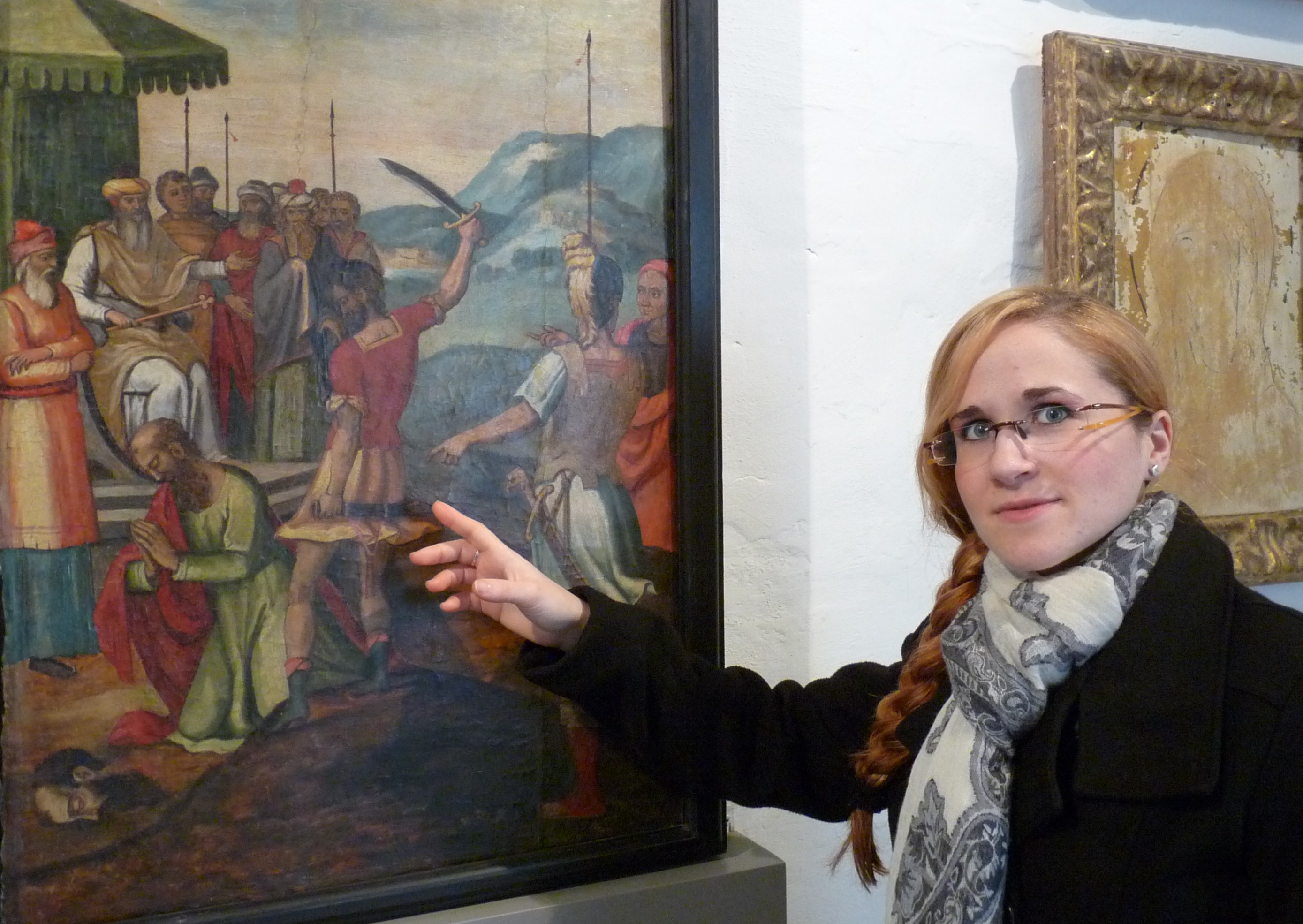
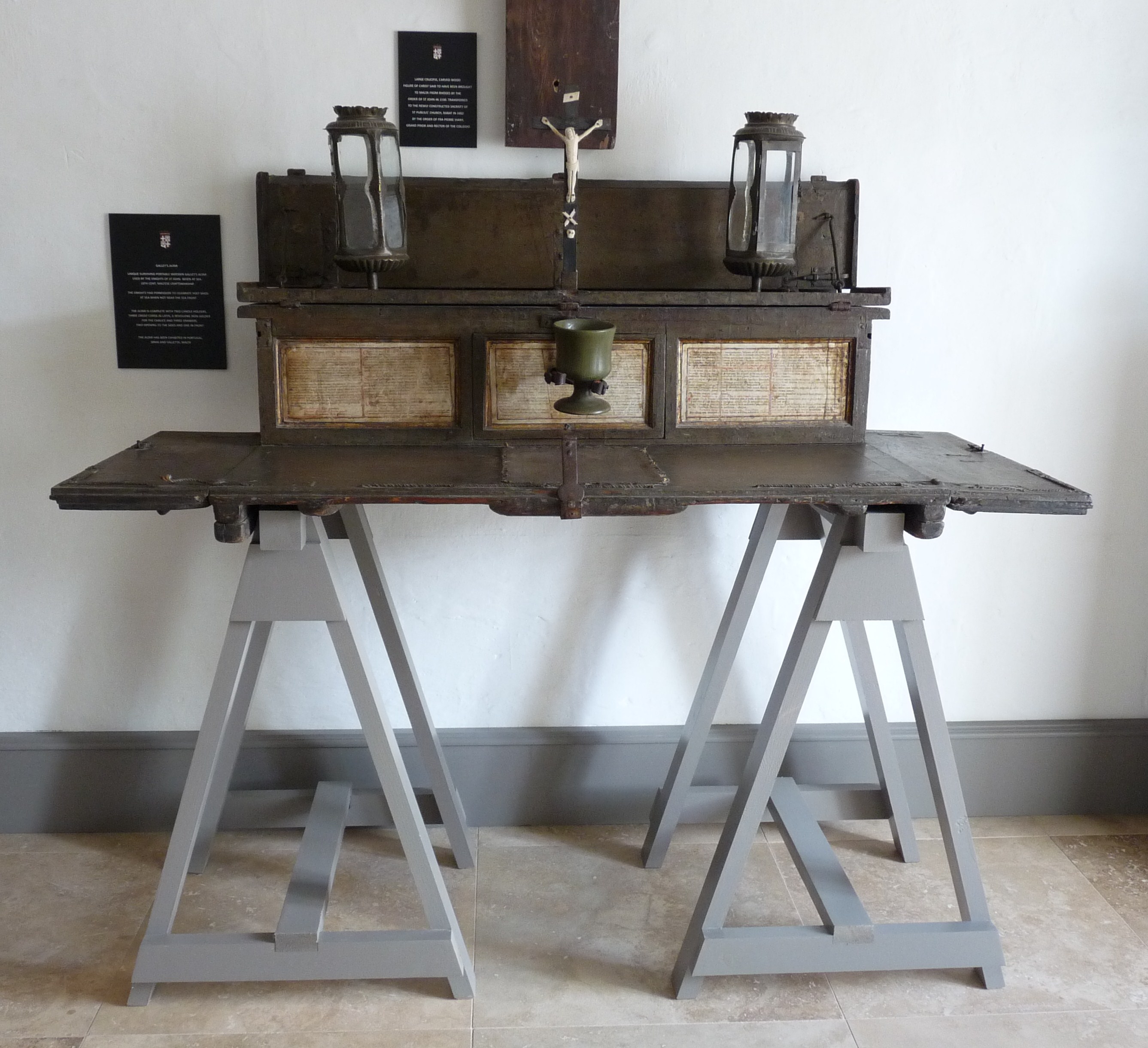
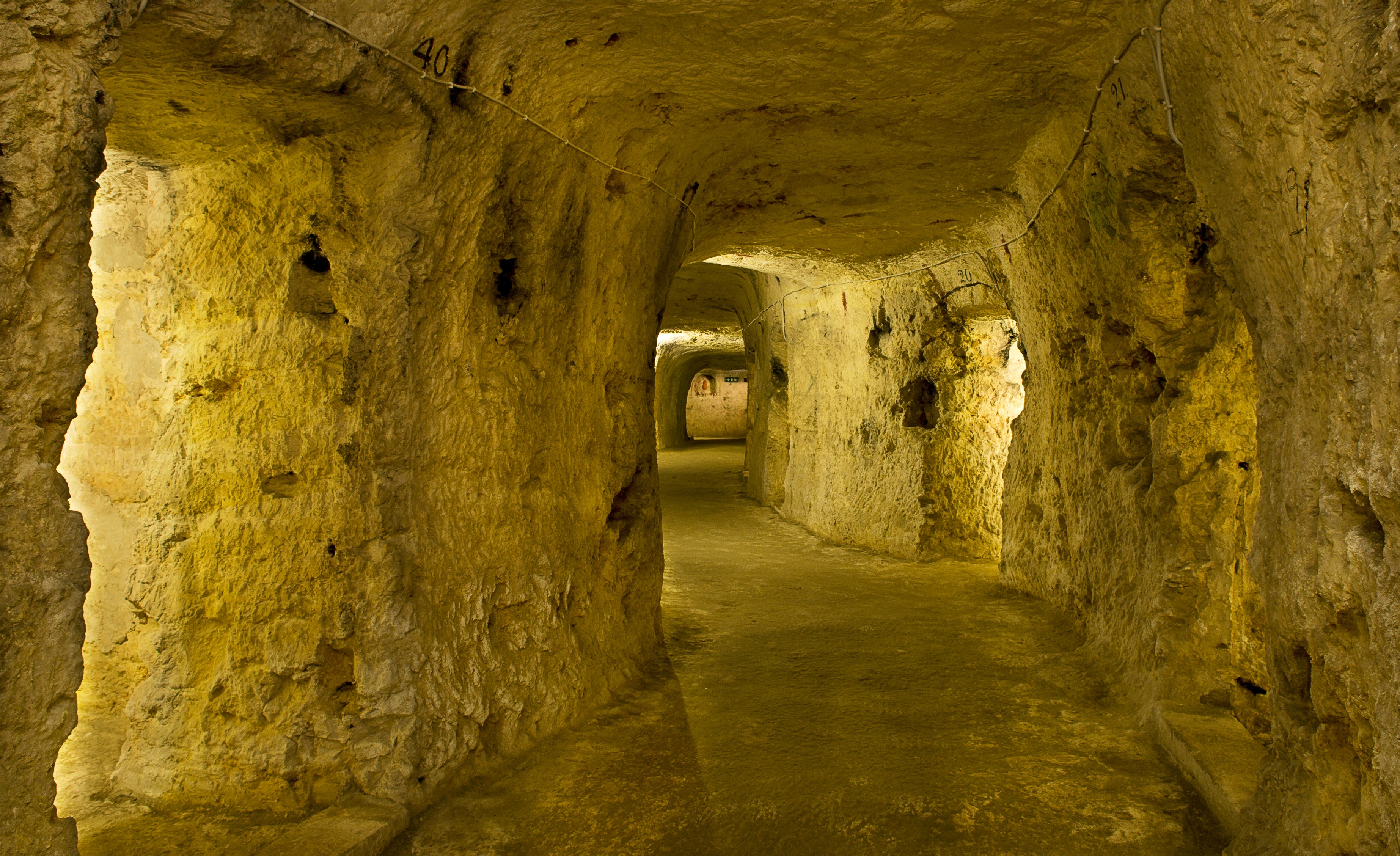
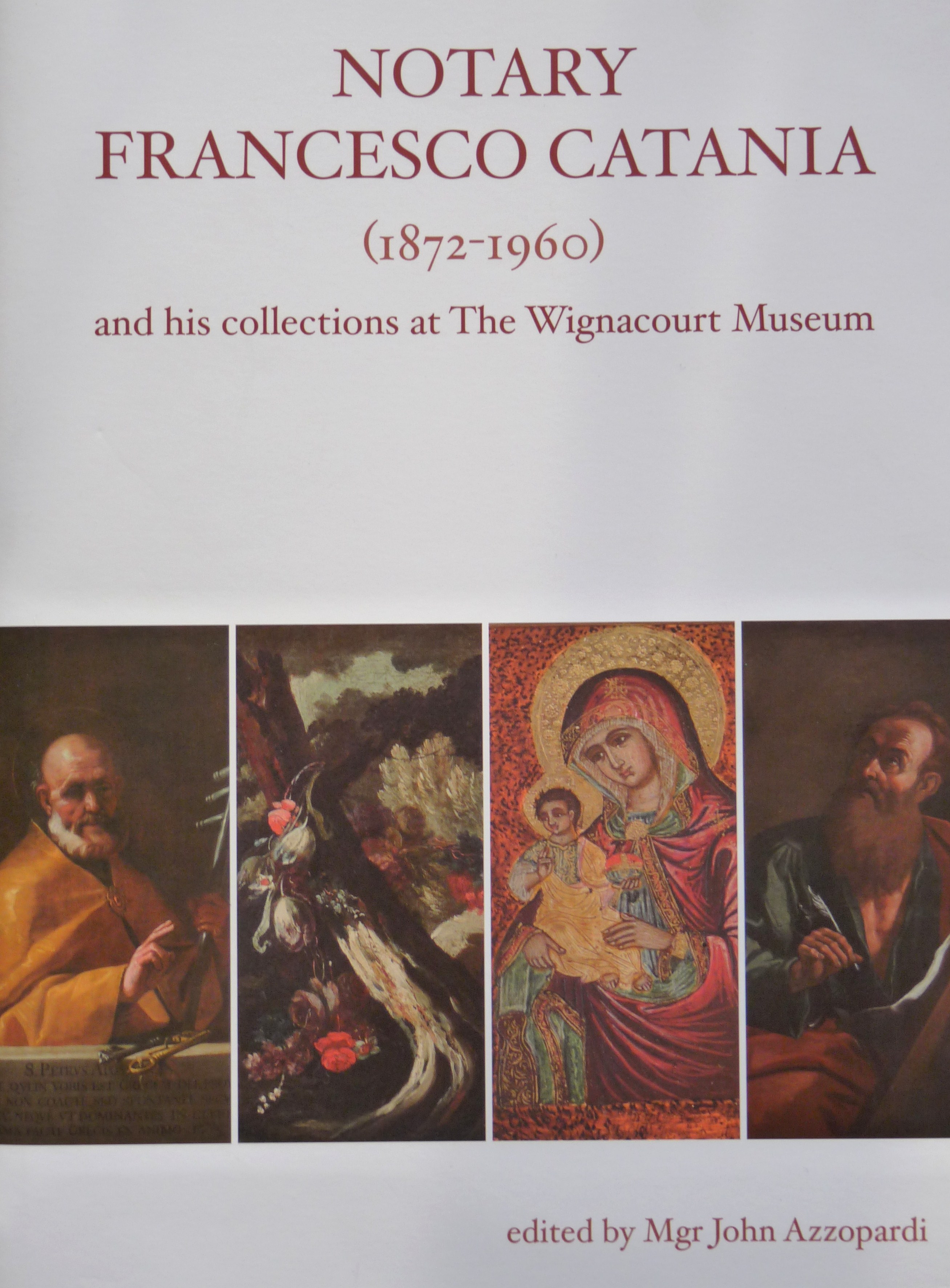


“Kif ħlisna mill-għarqa, sirna nafu li l-gżira kien jisimha Malta. In-nies tagħha ġabu ruħhom magħna bi ħlewwa liema bħalha. Laqgħuna tajjeb lilna lkoll u qabbdulna ħuġġieġa, għax kienet bdiet nieżla x-xita u kien il-bard….” Għoddni qed nilmaħ lill-appostlu San Luqa jikteb dawn il-vrus taħt id-dawl kiebi ta’fjamma ta’ xemgħa tperper maż-żiffa dieħla fil-kamra. L-istess ġabra ta’ kliem li llum, wara dawn is-snin kollha, għadna nisimgħu jinqara kull sena waqt il-quddiesa taċ-ċelebrazzjoni tal-miġja ta’ San Pawl f’pajjiżna. Jingħad li fis-sena 60 W.K., San Pawl waqqaf l-ewwel knisja f’Malta, proprju fil-grotta tar-Rabat, fejn kien qiegħed jiġi miżmum bħala ħabsi. U minn hemm beda l-kult qawwi Pawlin li matul is-snin ġibed lil bosta barranin lejn pajjiżna, hekk kif dawn xtaqu jmiddu passejhom fuq l-istess art li mexa fuqha dan il-qaddis. Hekk kif Frar huwa sinonimu ma’ din il-ġrajja tant kbira, għal dil-ġimgħa għażilt li nżur il-kumpless tal-Mużew Wignacourt li jinsab ir-Rabat, liema binja twassal ukoll għall-grotta ta’ San Pawl. Madanakollu, hekk kif flimkien mal-Kuratur Dun Ġwann Azzopardi u mal-Assistenta Kuratriċi, Michelle Galea, dort il-livelli varji li fih dan il-post, bqajt sorpriża kemm fir-realtà dan is-sit huwa ġawhra ta’ wirt kulturali li ma jkoprix biss din il-ġrajja imma anki diversi perjodi oħra tal-istorja għanja ta’ pajjiżna.
Tassew, kienet il-grotta li llum hija magħrufa bħala Ta’ San Pawl, li nisslet ir-reverenza lejn din il-biċċa art. Iżda minn hemm, ftit ftit, tqanqal moviment sħiħ, hekk kif l-awtoritajiet responsabbli minn dil-grotta, għarfu l-valur ta’ dan il-post u bdew jużaw din is-sitwazzjoni għal diversi għanijiet, sakemm illum insibu numru ta’ binjiet li twaqqfu fuq dan is-sit reliġjuż. Intant, kull min iżur il-Mużew Wignacourt u jiġi akkumpanjat mill-Kuraturi, inkella jagħżel li jdur mal-post permezz ta’ audio-guide, għandu l-opportunità li jesperjenza dawn it-tibdiliet li fosthom jinkludu l-grotta ta’ San Pawl, labirint sħiħ ta’ ipoġew taż-Żminijiet Feniċi, Rumani u Kristjani, grupp ta’ xelters imħaffra f’qiegħan l-art matul it-Tieni Gwerra Dinjija, u mużew mogħni b’kollezzjonijiet differenti u interessanti.
Inżilt flimkien ma’ Michelle lejn il-grotta ta’ San Pawl u hemm qattgħajna ftit ħin fis-silenzju, nosservaw is-sempliċità tagħha, kif jixraq. M’hemm l-ebda dokument li jikkonferma li kienet proprju din il-grotta li kien fiha San Pawl meta kien f’pajjiżna. Imma min-naħa l-oħra, illum għandna biżżejjed tagħrif biex nagħrfu fejn kienet il-belt Melite u sa fejn kienu jaslu l-konfini tagħha. B’hekk nistgħu nikkalkulaw fejn kienu l-ħabsijiet ta’ dak il-perjodu, li ġeneralment kienu jinsabu eżatt barra l-belt. U minn xi sinjali fis-soqfa tal-grotta nnifisha, hemm indikazzjoni qawwija li din setgħet kienet tintuża bħala ħabs. Huwa fatt kurjuż illi l-kult ta’ San Pawl ma ħax mill-ewwel fost il-Maltin, kemm minħabba li dawn kellhom l-allat tagħhom u probabbilment anki minħabba t-theddida tal-preżenza tar-Rumani li kienu qed jippersegwitaw lill-Kristjani.
Infatti jidher illi kien il-patri eremita Spanjol, Juan Benegas de Cordoba, li kabbar din id-devozzjoni meta fis-17 il-seklu, huwa żar din il-grotta u din tant laqtitu li ddeċieda li jiddedika ħajtu biex jippromwovi din id-devozzjoni lejn San Pawl fil-gżejjer tagħna. Il-ħsieb tiegħu rnexxa, hekk kif dan beda jattratta lejn pajjiżna ammont kbir ta’ pellegrini sabiex iżuru dan il-post. Dan il-fatt ġibed ukoll l-attenzjoni tal-Gran Mastru Fra Alof de Wignacourt li ma damx wisq ma għaraf il-potenzjal ta’ sit bħal dan u xtaqu li jsir tal-Ordni peress li din ma kellha l-ebda proprjetà li kienet abbinata ma’ dan il-qaddis, filwaqt li d-Djoċesi ta’ Malta kellha aktar minn post wieħed. Wara diversi diskussjonijiet, fosthom mal-Papa Pawlu V, ġie deċiż li l-grotta ta’ San Pawl kellha tgħaddi f’idejn il-kustodja ta’ l-Ordni u tinfired minn mal-parroċċa ddedikata lill-istess qaddis li kienet inbniet fis-16 il-seklu, sabiex din tibqa’ tal-Isqof u tal-poplu. Min-naħa tiegħu l-Gran Mastru kien obbligat li jipproteġi l-grotta u li jagħmilha disponibbli għall-pellegrini. B’hekk huwa ordna l-kostruzzjoni ta’ palazz maħsub għall-Kappillani ta’ l-Ordni li kellhom ir-responsabbiltà li jieħdu ħsieb is-sigurtà ta’ din il-grotta lejl u nhar. M’hemmx għalfejn ngħidu, dan kien ukoll mezz li bih setgħu jintlaqgħu wkoll l-aqwa nobbiltà ta’ dak iż-żmien f’pajjiżna fejn apparti li dawn kienu jkunu miġbuda mill-ispiritwalità tal-post, dawn kienu jiġu attratti wkoll mill-prestiġju tal-Ordni u probabbilment kienu jħallu xi kemxa ġmielha warajhom. Fil-fatt fuq il-grotta, l-Ordni bniet ukoll knisja ċkejkna ddedikata lil San Publiju fejn illum il-viżitaturi jistgħu jaraw dak li ħallewlna l-kavallieri f’dan il-post, fosthom kwadru titulari li juri xbieha tal-Madonna bil-Bambin li qed iżomm f’idejh is-salib ta’ l-Ordni, liema xogħol huwa tal-artist Mattia Preti.
Il-mawra fil-Mużew ta’ Wignacourt issa niżlitna ‘l isfel, lejn il-katakombi msawwra fil-blat tal-madwar. Ikolli ngħid li kont impressjonata ferm bl-istat tajjeb ta’ konservazzjoni ta’ dan is-sit. Ta’ min isemmi illi dan il-mużew għamel madwar sena u nofs magħluq sabiex isirlu r-restawr u l-konservazzjoni li kellu bżonn, wara li kien ilu miftuħ mill-1981, u kien f’Diċembru tal-2013 li reġa’ nfetaħ għall-pubbliku. Il-katakombi jkopru perjodi differenti fl-istorja u jitfgħu dawl sinifikanti fuq ir-ritwali ta’ dak iż-żmien. Kif bosta minnha jafu, dawn l-inħawi tar-Rabat huma miżgħuda b’dawn il-katakombi li llum jinsabu mifruxa taħt id-djar tal-madwar u minn żmien għall-ieħor nisimgħu b’xi skoperta ta’ xi parti oħra tagħhom. Infatti, ġara l-istess hawn ukoll fejn f’dawn l-aħħar snin, waqt xi xogħolijiet li kienu qed isiru, inkixfet parti oħra żgħira ta’ katakombi li fiha nstabet agape table li madwarha n-nies kienu jiċċelebraw il-vjaġġ tal-mejjet lejn dinja aħjar permezz ta’ ikla bejniethom. Sfortunatament, il-katakombi kollha li jinsabu ġo dan il-post ġew imbattla milli kien fihom u minflok intlew bit-terrapien waqt it-Tieni Gwerra Dinjija sabiex tissaħħaħ l-art ħalli taħtha jitħaffru aktar xelters. Min jaf x’qatt instab u x’qatt ittieħed minn dawn il-katakombi matul is-snin! Imma f’qabar minnhom, ġewwa din il-parti ċkejkna tal-katakombi li nstabet dan l-aħħar, wieħed għadu jista’ jara xi għadam uman li b’xi mod irnexxielu jiskappa d-destin li għaddew minnu l-oqbra l-oħra.
Taraġ ieħor aktar ‘l isfel li donnu jieħdok fil-qalba tal-art, iwassal għax-xelters li kellhom jitħaffru malajr sabiex joffru protezzjoni lin-nies tal-inħawi waqt l-attakki kiefra tal-gwerra. Mill-ġdid, dawn ix-xelters miżmuma f’kundizzjoni mill-iprem, jitfgħu dawl differenti lil realtà oħra li għex il-poplu tagħna f’passat aktar riċenti. F’dawn ix-xelters, wieħed isib ħamsin kamra b’kollox u meta wieħed jgħodd kemm kienu jesgħu nies anki l-kurituri ta’ bejniethom, ġie kkalkulat li setgħu jilqgħu fihom madwar 350 persuna. Fatt interessanti huwa li wħud minn dawn il-kmamar ġew imżejjna, kemm billi nżebgħu l-ħitan tagħhom, u anki permezz ta’ madum sabiħ kollu diżinji kkuluriti. Jagħtik li taħseb li anki f’dan iż-żmien imwiegħer u f’din is-sitwazzjoni ta’ tbatija u ta’ biża’, kien hemm min ittanta jsebbaħ anki din it-toqba fil-blat, forsi biex jinsa l-kruha. Madanakollu, fir-rigward ta’ kamra minnhom partikolarment aktar imdaqqsa u rranġata, kien hemm xi anzjani Rabtin li taw indikazzjoni li din kienet qed tiġi użata biex in-nisa tqal setgħu jwelldu t-trabi tagħhom fiha jekk jinqabdu waqt xi attakk mill-ajru. Ikun tassew interessanti li kieku nsibu lil xi ħadd li għadu jiftakar dan iż-żmien u jittieħed rikordju bil-miktub u idealment viżwali tal-memorji tiegħu.
Finalment kien imiss li nerġgħu nitilgħu ‘l fuq u hekk kif ħriġna fil-modernità tal-mużew, għal ftit mumenti ħassejt l-impressjoni li kont għadni kif tlajt minn dinja oħra. Anki dan il-mużew huwa maqsum f’żewġ partijiet. Fin-naħa t’isfel wieħed jista’ japprezza l-arkitettura sabiħa tal-post u jifli xi kollezzjonijiet, fosthom 49 mudell ta’ kappella maħdumin minn George Pellegrini Petit; oġġetti antiki li kienu jintużaw fil-funerali, bħal katallett tal-epoka barokka; tagħmir tal-knisja inkluż ċuqlajta kbira li kienet tintuża fil-ġimgħa l-kbira, u għadd ta’ buzzetti artistiċi tal-iskultur magħruf Anton Agius li ġew mgħoddija minn martu bħala donazzjoni lil dan il-mużew. Oġġett mhux tas-soltu miżmum hawnhekk hija l-karozza Austin Six Limousine tal-1937, li dari kienet tintuża mill-Arċisqof Dom Maurus Caruana u mill-Arċisqof Mons. Mikiel Gonzi.
Fis-sular ta’ fuq, il-viżitaturi jistgħu josservaw il-lussu tal-palazz li dari kien tal-Kappillani tal-Ordni u li llum huwa mibdul fi swali ta’ esebizzjonijiet varji. Parti kbira mill-esebizzjonijiet tinkludi bosta xogħolijiet tal-arti ta’ wħud mill-aqwa artisti bħal Vincenzo Hyzler, Francesco Zahra, Giuseppe Calì, Antoine Favray u Mattia Preti. L-iktar pittura antika fil-kollezzjoni ta’ dan il-mużew huwa kwadru poliptiku tal-1588 li llum hu ffurmat minn ħames partijiet fejn fihom wieħed isegwi l-ħajja ta’ San Pawl. Xogħol ieħor interessanti juri xbieha tad-Duluri li ġiet impinġija fuq injama ta’ daqs żgħir minn Mattia Preti. Minħabba li din ix-xbieha nħadmet b’lewn wieħed kjar oskur u peress li m’għandix is-soliti movimenti bħall-pitturi oħra, hemm min jaħseb li l-artist seta’ ħadem din il-pittura għalih biex iġorrha miegħu bħala speċi ta’ santa. Esebizzjonijiet oħra jinkludu relikwi, fosthom anki kopja tal-liżar ta’ Turin li ġiet awtentikata fl-1663, kwadri tal-ex-voto, paramenti ta’ Papa Pawlu V, mapep antiki u numru ta’ artifatti arkeoloġiċi li jingħad li nstabu fl-inħawi tal-Baħrija u tar-Rabat. Esebit ieħor interessanti huwa artal portabbli li kien jintuża fuq ix-xwieni; oġġett rari li probabbilment bħalu wieħed isib biss f’xi kollezzjoni privata. Wieħed jista’ jżur ukoll il-kamra tal-Kapitli mgħonija b’għadd ta’ kwadri ta’ Gran Mastri differenti, fosthom dak ta’ Wignacourt. Imbagħad hemm ukoll il-kappella li kienu jużaw il-kavallieri u sepulkru li kien jintrama f’Ħamis ix-Xirka. Kamra oħra li laqtitni kienet dik tat-teżorier li fuq is-sodda tiegħu, fl-għoli fuq ir-raff, imma dejjem taħt għajnejh, kien iżomm il-kaxxa tal-flus ħalli jipprova jevita milli xi ħadd jisraqhielu.
Huwa importanti li wieħed ikun jaf li parti kbira minn dawn il-kollezzjonijiet li wieħed jista’ jara f’din is-sezzjoni tal-mużew, għaddiet hawnhekk bħala donazzjoni fl-1960, permezz ta’ wirt li ħalla n-Nutar Francesco Catania, li kien magħruf ħafna r-Rabat. Il-kollezzjonijiet li ġew minn għandu kienu jinkludu kwadri, għamara, diżinji, kotba, mapep, u artifatti arkeoloġiċi imprezzabbli. Dun Ġwann Azzopardi spjegali kif hu kellu x-xorti li jiltaqa’ man-Nutar Catania li spiss kien jinkoraġġih biex jinteressa ruħu fl-istorja sħiħa ta’ dan il-kumpless Pawlin. Mur għid lin-nutar li fl-1981, kellu jkun proprju Dun Ġwann li kellu jkun l-ewwel Kuratur ta’ dan il-mużew. Aktar minn hekk, min jaf qattx basar li l-istess qassis kien ser ikun l-editur tal-ktieb ‘Notary Francesco Catania (1872-1960) and his collections at the Wignacourt Museum’ li ser joħroġ għall-bejgħ mill-ġimgħa d-dieħla. Dan il-ktieb li fih 440 illustrazzjoni, jinkludi wkoll għadd ta’ materjal informattiv dwar il-Mużew Wignacourt u dwar in-Nutar Catania u l-kollezzjonijiet tiegħu. Fosthom wieħed isib numru ta’ studji u ta’ katalogi li jagħtu tagħrif siewi dwar dawn il-kollezzjonijiet: bħal ngħidu aħna katalogu tal-kwadri li ġie ppreparat minn Antonio Espinosa Rodriguez li kien Kuratur tal-Mużew Marittimu ta’ Malta u aktar tard tal-Mużew tal-Arti; katalogu tal-artifatti arkeoloġiċi tal-Perjodi Feniċi, Puniċi u Rumani li ġie mfassal mis-Superintendent tal-Wirt Kulturali, Anthony Pace; studju tad-diżinji li sar mill-Kuratriċi tal-Mużew Nazzjonali tal-Arti, Bernadine Scicluna, u studju ta’ mappa ta’ Malta tal-1833 li twettaq mill-avukat u espert fil-qasam tal-mapep, Dr Albert Ganado.
Bla dubju, il-Mużew Wignacourt joffri esperjenza distinta lil kull min iżuru, hekk kif dan il-post u l-kollezzjonijiet tiegħu, kapaċi jolqtu għadd ta’ interessi differenti. Peress li wieħed jeħtieġ iqatta’ siegħa jew tnejn jekk irid jara sewwa dan il-post, kafetterija li tinsab f’dan il-mużew, tkompli ssaħħaħ il-professjonalità ta’ dan is-sit li għandu jkun xempju għas-siti kulturali kollha tagħna.
Il-Mużew Wignacourt jinsab fi Triq il-Kulleġġ, ir-Rabat. Għal aktar informazzjoni, tistgħu ċċemplu fuq 27494905.
(Dan l-artiklu ġie ppubblikat fis-sensiela ĠABRIET IT-TIFKIRIET (17 il-parti) tat-Torċa tat-23 ta’ Frar 2014)
-
THE SICILIAN CONNECTION – Archaeotur Project
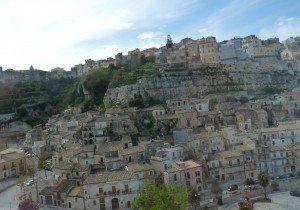 Though many Maltese tend to perceive their archipelago as a solitary group of islands in the centre of the Mediterranean Sea, the nearby island Sicily has always been closely present both geographically and often historically. The Archaeotur project aims to enhance the rediscovery of the archaeological and cultural identities of both islands, particularly by setting up a set of heritage trails which link a number of renowned sites together with other interesting locations that are presently found off the usual beaten tourist track.
Though many Maltese tend to perceive their archipelago as a solitary group of islands in the centre of the Mediterranean Sea, the nearby island Sicily has always been closely present both geographically and often historically. The Archaeotur project aims to enhance the rediscovery of the archaeological and cultural identities of both islands, particularly by setting up a set of heritage trails which link a number of renowned sites together with other interesting locations that are presently found off the usual beaten tourist track.On crisp clear nights, some Sicilians search out for Malta’s twinkling lights across the separating sea known as the channel of Malta. Similarly during a fine limpid day, the area of Mount Etna is distinctly visible from Mdina. One may thus wonder how the ancient populations of these islands might have regarded this ‘nearness’ and what they might have shared. The Archaeotur project focuses on these similarities but also on the differences which vividly portray an affinity but no less a diversity between the two places, thereby enticingly creating a new world to discover just a few kilometres away.
 During last April, a group of Maltese experts in archaeology and in cultural tourism, together with a number of local university students, attended a three-day seminar that was held at the Auditorium San Vincenzo Ferreri in Ragusa Ibla. The Maltese and Sicilian counterparts discussed the plans of the Archaeotur project, gave detailed descriptions of some of the concerned archaeological sites and the findings discovered within, and shared information and ideas about what has been done so far and what work still needs to be tackled so that these sites are conserved and presented in the most professional way to all the visitors.
During last April, a group of Maltese experts in archaeology and in cultural tourism, together with a number of local university students, attended a three-day seminar that was held at the Auditorium San Vincenzo Ferreri in Ragusa Ibla. The Maltese and Sicilian counterparts discussed the plans of the Archaeotur project, gave detailed descriptions of some of the concerned archaeological sites and the findings discovered within, and shared information and ideas about what has been done so far and what work still needs to be tackled so that these sites are conserved and presented in the most professional way to all the visitors. Residing in a small hotel in Ragusa Ibla, the Maltese participants could indulge in the historical aura of the oldest part of this town. Narrow alleys with speeding motorini and compact vans running through them led to some impressive medieval buildings and baroque palaces. Interestingly much of this area had to be rebuilt after a very strong earthquake hit Ragusa on the 11th January 1693, killing about 5000 people and destroying many remarkable buildings such as a castle, palaces, churches, and many houses. After this catastrophe, some survivors in Ragusa wanted to rebuild the destroyed part of the town in the same place whilst others preferred to build their residences in another area, thereby creating two facets of this town which eventually became known as the old and the modern Ragusa. Three bridges which connect the older part to the new part of the town have inspired people to identify Ragusa as the city of bridges. These bridges provide a stunning view of this historical town, its buildings huddled closely together, as if clinging for life to the strong high precipice. In the last years, the old centre has been revived again with the opening of a number of shops, bars, restaurants and hotels. Indeed, Ragusa’s distinguished Sicilian character has attracted many photographers and film producers, the latest of which being the popular Italian TV series of ‘Il Commissario Montalbano’.
Residing in a small hotel in Ragusa Ibla, the Maltese participants could indulge in the historical aura of the oldest part of this town. Narrow alleys with speeding motorini and compact vans running through them led to some impressive medieval buildings and baroque palaces. Interestingly much of this area had to be rebuilt after a very strong earthquake hit Ragusa on the 11th January 1693, killing about 5000 people and destroying many remarkable buildings such as a castle, palaces, churches, and many houses. After this catastrophe, some survivors in Ragusa wanted to rebuild the destroyed part of the town in the same place whilst others preferred to build their residences in another area, thereby creating two facets of this town which eventually became known as the old and the modern Ragusa. Three bridges which connect the older part to the new part of the town have inspired people to identify Ragusa as the city of bridges. These bridges provide a stunning view of this historical town, its buildings huddled closely together, as if clinging for life to the strong high precipice. In the last years, the old centre has been revived again with the opening of a number of shops, bars, restaurants and hotels. Indeed, Ragusa’s distinguished Sicilian character has attracted many photographers and film producers, the latest of which being the popular Italian TV series of ‘Il Commissario Montalbano’.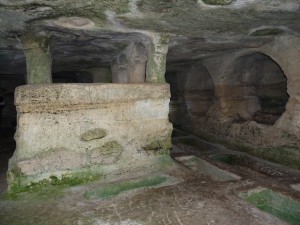 The seminars’ participants were also given the opportunity to visit some of the locations that are included in the Archaeotur project in order to understand better the significance and value of this endeavor. One of the most outstanding was certainly the catacomb of the Grotta delle Trabacche in Ragusa. Recently, this catacomb has been thoroughly cleaned out and conserved, and information posts have been placed in the vicinity in order to guide those visiting this site. Two central opulent and monumental tombs within this catacomb indicate that two individuals who had some importance or a form of authority in their society were buried there. Moreover, one finds several other common tombs that were dug out of the walls and floors of the cavern.
The seminars’ participants were also given the opportunity to visit some of the locations that are included in the Archaeotur project in order to understand better the significance and value of this endeavor. One of the most outstanding was certainly the catacomb of the Grotta delle Trabacche in Ragusa. Recently, this catacomb has been thoroughly cleaned out and conserved, and information posts have been placed in the vicinity in order to guide those visiting this site. Two central opulent and monumental tombs within this catacomb indicate that two individuals who had some importance or a form of authority in their society were buried there. Moreover, one finds several other common tombs that were dug out of the walls and floors of the cavern.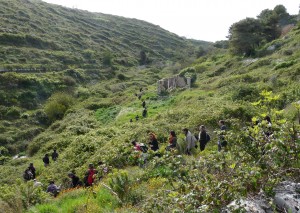 Ironically although hypogea and catacombs are directly connected with death, these sites tend also to provide crucial information about the life and the rituals of the living individuals who used these places. Therefore for example, a multitude of catacombs that are present in Cava Celone might be expressing the situation of an increasing population. These archaeological sites are magnificently enfolded within a wide valley full of wild vegetation, thus endowing the experience of visiting them with a sense of adventure; the silence reigning within the valley allows one to feel truly at one with nature. Meanwhile, the visit to three catacombs in this location revealed the work that still needs to be done on these archaeological sites, including cleaning, conserving, and planning a more practical path which the visitors could use for easy access.
Ironically although hypogea and catacombs are directly connected with death, these sites tend also to provide crucial information about the life and the rituals of the living individuals who used these places. Therefore for example, a multitude of catacombs that are present in Cava Celone might be expressing the situation of an increasing population. These archaeological sites are magnificently enfolded within a wide valley full of wild vegetation, thus endowing the experience of visiting them with a sense of adventure; the silence reigning within the valley allows one to feel truly at one with nature. Meanwhile, the visit to three catacombs in this location revealed the work that still needs to be done on these archaeological sites, including cleaning, conserving, and planning a more practical path which the visitors could use for easy access.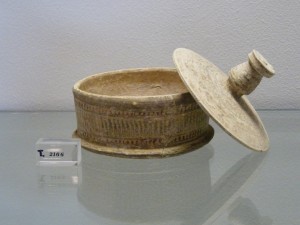 A visit to the Regional Museum of Camarina was undoubtedly distinctive especially because of the extraordinary display of a multitude of findings that were discovered both on land and under the sea of the Santa Croce Camarina area. Many of the artefacts discovered on land pertain to burial rites. Some of them are so refined that it is believed that they belonged to a Greek aristocracy who had immigrated to this area. On the other hand, the numerous objects that were recovered from several wrecks in the bay of Camarina demonstrate that many commercial ships passed through this zone. Among the prestigious exhibits, one finds a bronze archaic helmet that was recovered from a relic that lay seven metres under the sea in front of Punta Braccetto. Several amphorae, a classical Attic-Etruscan helmet, seventy-three clay lamps and some silver items were retrieved from two other relics that were buried in the middle of the bay. Likewise, in 1991, a huge storm revealed the treasure trove of a hoard of 6000 coins that was buried only 200 metres away from the coast.
A visit to the Regional Museum of Camarina was undoubtedly distinctive especially because of the extraordinary display of a multitude of findings that were discovered both on land and under the sea of the Santa Croce Camarina area. Many of the artefacts discovered on land pertain to burial rites. Some of them are so refined that it is believed that they belonged to a Greek aristocracy who had immigrated to this area. On the other hand, the numerous objects that were recovered from several wrecks in the bay of Camarina demonstrate that many commercial ships passed through this zone. Among the prestigious exhibits, one finds a bronze archaic helmet that was recovered from a relic that lay seven metres under the sea in front of Punta Braccetto. Several amphorae, a classical Attic-Etruscan helmet, seventy-three clay lamps and some silver items were retrieved from two other relics that were buried in the middle of the bay. Likewise, in 1991, a huge storm revealed the treasure trove of a hoard of 6000 coins that was buried only 200 metres away from the coast.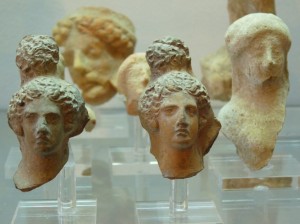 Undeniably, the participants in this seminar had a good taste of the potential of these Sicilian sites that are included in the project of Archaeotur. In the first week of September, a second seminar, this time organized in Malta, will once again reunite Maltese and Sicilian experts and participants so that they can evaluate the work that has been done so far and also to visit some of the Maltese sites which form part of the Archaeotur project.
Undeniably, the participants in this seminar had a good taste of the potential of these Sicilian sites that are included in the project of Archaeotur. In the first week of September, a second seminar, this time organized in Malta, will once again reunite Maltese and Sicilian experts and participants so that they can evaluate the work that has been done so far and also to visit some of the Maltese sites which form part of the Archaeotur project.No doubt this EU project is proving of great benefit towards cross-border cooperation in the sector of heritage conservation and interpretation and no less to cultural tourism which is certainly of substantial benefit to both territories.
Archaeotur is a 1.37 million euro project which is co-financed under the Italia-Malta Programme Cohesion Policy 2007 – 2013 and is part-financed by the EU European Regional Development Fund. The partners involved within it are: Mosta and Rabat Local Councils, Heritage Malta, Malta Tourism Authority, the Comune of Ragusa and the Comune of Santa Croce Camarina, the Superintendence of BB.CC.AA Ragusa, the Archaeological Park of Camarina, and Giritravel SRL. The main purpose of this project is to conserve, interpret and market a number of archaeological sites which generally consist of hypogea and catacombs across the Maltese and Italian borders such as: Ta’ Bistra (Mosta), St Augustine (Rabat), Trabacche, Cava Celone, Cisternazzi and Donnafugata (Ragusa), and Mezzagnone, Pirrera and Mirio (Santa Croce Camarina).
Further information about the Archaeotur project may be obtained through the website www.archaeotur.eu or by contacting Archaeotur Curator, Glen Farrugia, on glen.farrugia@gov.mt
(Note: An edited version of this article was published on FIRST magazine Issue September 2012).
-
ARCHAEOTUR: PROĠETT LI JGĦAQQAD SITI KULTURALI F’MALTA U F’RAGUSA
 Bejn il-5 u s-7 ta’ Settembru 2012, fis-Sala Sant’Anġlu ġewwa l-Mużew Marittimu tal-Birgu, ser tiġi organizzata t-tieni parti ta’ seminar konness mal-proġett Archaeotur. Dawn il-laqgħat għandhom jinteressaw lil dawk kollha li għandhom għal qalbhom il-wirt kulturali nazzjonali u kif ukoll dak dinji. Għalkemm il-parteċipazzjoni f’dawn is-seminars hija b’xejn, huwa rakkommandat illi wieħed jirreġistra sabiex jirriserva post.
Bejn il-5 u s-7 ta’ Settembru 2012, fis-Sala Sant’Anġlu ġewwa l-Mużew Marittimu tal-Birgu, ser tiġi organizzata t-tieni parti ta’ seminar konness mal-proġett Archaeotur. Dawn il-laqgħat għandhom jinteressaw lil dawk kollha li għandhom għal qalbhom il-wirt kulturali nazzjonali u kif ukoll dak dinji. Għalkemm il-parteċipazzjoni f’dawn is-seminars hija b’xejn, huwa rakkommandat illi wieħed jirreġistra sabiex jirriserva post.Bejn is-sittax u t-tmintax-il seklu l-Grand Tour kien avventura popolari ħafna mal-familji aristokratiċi Ewropej. Infatti, bosta minnhom kienu jibagħtu lill-iben il-kbir tal-familja għall-vjaġġ ta’ sena madwar l-Ewropa sabiex hemm iżur is-siti klassiċi tal-arkeoloġija u b’hekk jifforma aħjar il-lat edukattiv u kulturali tiegħu. Uħud minn dawn kienu saħansitra jaslu sa Malta u fil-fatt fis-seklu sbatax insibu lil Ġan Franġisk Abela jakkompanja lill-viżitaturi ġewwa l-katakombi ta’ San Pawl. Għad illi għaddew bosta snin, il-ġibda għat-turiżmu kulturali għadha ħajja sewwa, tant li llum dan sar niċċa importanti fl-industrija turistika kemm Maltija u kif ukoll Ewropeja. Dan ifisser li hemm bżonn dejjem iżjed li ninvestu fil-partimonju kulturali u storiku sabiex nirrenduh aktar magħruf u miftuħ għall-pubbliku interessat.
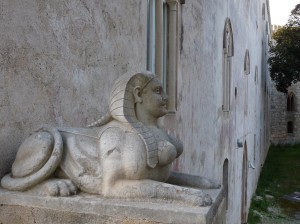 Il-proġett Archaeotur li ser jiswa 1.37 miljun ewro huwa kofinanzjat taħt il-Programm Italia-Malta, Cohesion Policy 2007–2013, u parzjalment iffinanzjat mill-Fond Ewropew tal-Iżvilupp Reġjonali. Fih hemm involuti il-Kunsill Lokali tal-Mosta u dak tar-Rabat (Malta), Heritage Malta, l-Awtorità Maltija għat-Turiżmu, il-Comune di Ragusa u l-Comune di Santa Croce Camarina, is-Superintendenza dei BB.CC.AA di Ragusa f’kollaborazzjoni mal-Parco Archaeologico di Camarina u Giritravel SRL. L-għan aħħari tal-proġett Archaeotur huwa l-konservazzjoni u l-promozzjoni ta’ numru ta’ siti arkeoloġiċi li bosta minnhom jikkonsistu f’ipoġej jew katakombi f’Malta u fi Sqallija: Ta’ Bistra (il-Mosta) u Santu Wistin (ir-Rabat), Trabacche, Cava Celone, Cisternazzi u Donnafugata (Ragusa), u Mezzagnone, Pirrera u Mirio (Santa Croce Camarina).
Il-proġett Archaeotur li ser jiswa 1.37 miljun ewro huwa kofinanzjat taħt il-Programm Italia-Malta, Cohesion Policy 2007–2013, u parzjalment iffinanzjat mill-Fond Ewropew tal-Iżvilupp Reġjonali. Fih hemm involuti il-Kunsill Lokali tal-Mosta u dak tar-Rabat (Malta), Heritage Malta, l-Awtorità Maltija għat-Turiżmu, il-Comune di Ragusa u l-Comune di Santa Croce Camarina, is-Superintendenza dei BB.CC.AA di Ragusa f’kollaborazzjoni mal-Parco Archaeologico di Camarina u Giritravel SRL. L-għan aħħari tal-proġett Archaeotur huwa l-konservazzjoni u l-promozzjoni ta’ numru ta’ siti arkeoloġiċi li bosta minnhom jikkonsistu f’ipoġej jew katakombi f’Malta u fi Sqallija: Ta’ Bistra (il-Mosta) u Santu Wistin (ir-Rabat), Trabacche, Cava Celone, Cisternazzi u Donnafugata (Ragusa), u Mezzagnone, Pirrera u Mirio (Santa Croce Camarina).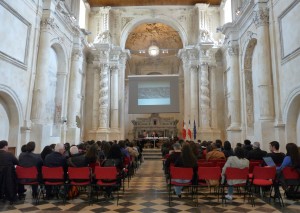 L-ewwel parti ta’ dawn is-seminars saret bejn il-11 u t-13 t’April 2012 ġewwa l-Auditorium San Vincenzo Ferreri f’Ragusa Ibla. Numru ta’ esperti f’dan il-qasam, kemm minn Malta u kif ukoll minn Sqallija, ddiskutew il-pjanijiet u l-miri tal-proġett Archaeotur, taw deskrizzjoni dettaljata ta’ xi siti u sejbiet arkeoloġiċi, u qasmu bejniethom ideat dwar ix-xogħol li qed isir u dak li għad irid jitwettaq sabiex dawn il-postijiet jiġu kkonservati u ppreżenati lill-viżitaturi bl-aktar mod professjonali.
L-ewwel parti ta’ dawn is-seminars saret bejn il-11 u t-13 t’April 2012 ġewwa l-Auditorium San Vincenzo Ferreri f’Ragusa Ibla. Numru ta’ esperti f’dan il-qasam, kemm minn Malta u kif ukoll minn Sqallija, ddiskutew il-pjanijiet u l-miri tal-proġett Archaeotur, taw deskrizzjoni dettaljata ta’ xi siti u sejbiet arkeoloġiċi, u qasmu bejniethom ideat dwar ix-xogħol li qed isir u dak li għad irid jitwettaq sabiex dawn il-postijiet jiġu kkonservati u ppreżenati lill-viżitaturi bl-aktar mod professjonali. Għal dawn is-seminars attendew ukoll numru ta’ studenti universitarji kemm Maltin u kif ukoll Sqallin, li flimkien mal-kelliema kellhom ukoll l-opportunità li jżuru wħud minn dawn is-siti sabiex b’hekk jifhmu aħjar is-sinifikat tal-proġett Archaeotur. Ngħidu aħna fil-Grotta delle Trabacche f’Ragusa kien evidenti x-xogħol ta’ tindif u konservazzjoni li kien sar fil-post fejn anki tpoġġew tabelli b’tagħrif għall-viżitaturi. Dan il-katakombi huwa meqjus bħala wieħed mis-siti l-aktar sinifikanti, l-aktar minħabba l-grandjożità monumentali ta’ żewġ oqbra li jinsabu fiċ-ċentru tiegħu, mdawwrin b’oqbra aktar sempliċi mħaffra fil-ħitan u fl-art tal-għar. Indubbjament dawn jagħtu indikazzjoni li almenu żewġ individwi ta’ ċerta importanza jew awtorità fis-soċjetà tal-madwar indifnu hemm.
Għal dawn is-seminars attendew ukoll numru ta’ studenti universitarji kemm Maltin u kif ukoll Sqallin, li flimkien mal-kelliema kellhom ukoll l-opportunità li jżuru wħud minn dawn is-siti sabiex b’hekk jifhmu aħjar is-sinifikat tal-proġett Archaeotur. Ngħidu aħna fil-Grotta delle Trabacche f’Ragusa kien evidenti x-xogħol ta’ tindif u konservazzjoni li kien sar fil-post fejn anki tpoġġew tabelli b’tagħrif għall-viżitaturi. Dan il-katakombi huwa meqjus bħala wieħed mis-siti l-aktar sinifikanti, l-aktar minħabba l-grandjożità monumentali ta’ żewġ oqbra li jinsabu fiċ-ċentru tiegħu, mdawwrin b’oqbra aktar sempliċi mħaffra fil-ħitan u fl-art tal-għar. Indubbjament dawn jagħtu indikazzjoni li almenu żewġ individwi ta’ ċerta importanza jew awtorità fis-soċjetà tal-madwar indifnu hemm.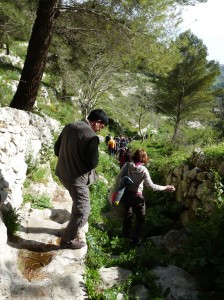 Ironikament, dawn il-postijiet konnessi mal-mewt għandhom ħabta jservu bħala fonti kruċjali ta’ informazzjoni dwar il-ħajja u l-użanzi tan-nies li sawwruhom u użawhom għall-bżonnijiet u r-ritwali tagħhom. Għalhekk, il-kwantità ta’ katakombi li wieħed isib f’Cava Celone, jista’ jkun li qed tirrappreżenta żieda sostanzjali fil-popolazzjoni ta’ dak iż-żmien. Iż-żjara fi tliet katakombi maġġuri wriet li f’dawn il-postijiet kien għad fadal ħafna xogħol xi jsir, speċjalment biex jitfasslu sinjali, mogħdijiet u trejqat aktar adegwati ħalli dawn il-postijiet jintlaħqu aktar faċilment mill-viżitaturi. Wieħed ma jistax ma jsemmix li dawn l-inħawi jinsabu f’wied mill-isbaħ, mogħni b’natura mhux mittiefsa fejn b’hekk il-viżitatur jista’ jitpaxxa bil-ġmiel tal-post filwaqt li jgawdi mis-sens tal-avventura li toffri kull esplorazzjoni.
Ironikament, dawn il-postijiet konnessi mal-mewt għandhom ħabta jservu bħala fonti kruċjali ta’ informazzjoni dwar il-ħajja u l-użanzi tan-nies li sawwruhom u użawhom għall-bżonnijiet u r-ritwali tagħhom. Għalhekk, il-kwantità ta’ katakombi li wieħed isib f’Cava Celone, jista’ jkun li qed tirrappreżenta żieda sostanzjali fil-popolazzjoni ta’ dak iż-żmien. Iż-żjara fi tliet katakombi maġġuri wriet li f’dawn il-postijiet kien għad fadal ħafna xogħol xi jsir, speċjalment biex jitfasslu sinjali, mogħdijiet u trejqat aktar adegwati ħalli dawn il-postijiet jintlaħqu aktar faċilment mill-viżitaturi. Wieħed ma jistax ma jsemmix li dawn l-inħawi jinsabu f’wied mill-isbaħ, mogħni b’natura mhux mittiefsa fejn b’hekk il-viżitatur jista’ jitpaxxa bil-ġmiel tal-post filwaqt li jgawdi mis-sens tal-avventura li toffri kull esplorazzjoni.Infatti l-proġett Archaeotur huwa ffukat fuq it-tisħiħ tal-valur tal-esperjenza tat-turiżmu kulturali fejn it-turist ikun jista’ jżur għażla ta’ siti ta’ interess permezz ta’ heritage trails li jgħaqqdu f’itinerarju wieħed numru ta’ siti li forsi s’issa ma kinux qed jingħataw daqshekk importanza. Ngħidu aħna bosta turisti li jżuru l-kastell ta’ Donnafugata f’Ragusa probabbilment ma jafux li tefgħa ta’ ġebla ’l bogħod, mogħdija dejqa mistura fil-ħdura ta’ natura mill-iprem, twassal għal katakombi ċkejken li jmur lura għar-raba’ jew il-ħames seklu W.K.
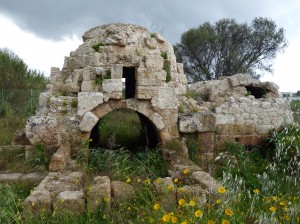 L-istess nistgħu ngħidu għall-fdalijiet arkeoloġiċi mhux tas-soltu li jinsabu f’nofs ta’ għalqa ġewwa Mezzagnone f’Santa Croce Camarina. Din il-binja, li ilha tqanqal l-kurżità tal-istudjużi sa minn żmien twil, hija maħsuba li tmur lura għal bejn ir-raba’ u d-disgħa seklu W.K. u li għal xi żmien intużat bħala banju termali. Inċidentalment, dawk li jżuru dan il-post jistgħu jkomplu triqithom ftit kilometri oħra sabiex japprezzaw il-kollezzjoni arkeoloġika vasta li tinsab fil-Mużew Reġjonali ta’ Camarina. Imfittex minn bosta studjużi, partikolarment minħabba l-għadd kbir ta’ anfori ta’ tipi differenti li jħaddan fih, dan il-Mużew huwa mogħni b’sejbiet sinifikanti li nstabu fl-inħawi kemm taħt l-art u kif ukoll taħt il-baħar. Bosta mill-oġġetti li ġew skavati mill-art huma konnessi mar-ritwali tad-dfin, uħud minnhom tant huma raffinati u prestiġġjużi, li huwa maħsub li kienu jappartjenu lill-ewwel immigranti aristokratiċi Griegi li marru joqogħdu
L-istess nistgħu ngħidu għall-fdalijiet arkeoloġiċi mhux tas-soltu li jinsabu f’nofs ta’ għalqa ġewwa Mezzagnone f’Santa Croce Camarina. Din il-binja, li ilha tqanqal l-kurżità tal-istudjużi sa minn żmien twil, hija maħsuba li tmur lura għal bejn ir-raba’ u d-disgħa seklu W.K. u li għal xi żmien intużat bħala banju termali. Inċidentalment, dawk li jżuru dan il-post jistgħu jkomplu triqithom ftit kilometri oħra sabiex japprezzaw il-kollezzjoni arkeoloġika vasta li tinsab fil-Mużew Reġjonali ta’ Camarina. Imfittex minn bosta studjużi, partikolarment minħabba l-għadd kbir ta’ anfori ta’ tipi differenti li jħaddan fih, dan il-Mużew huwa mogħni b’sejbiet sinifikanti li nstabu fl-inħawi kemm taħt l-art u kif ukoll taħt il-baħar. Bosta mill-oġġetti li ġew skavati mill-art huma konnessi mar-ritwali tad-dfin, uħud minnhom tant huma raffinati u prestiġġjużi, li huwa maħsub li kienu jappartjenu lill-ewwel immigranti aristokratiċi Griegi li marru joqogħdu 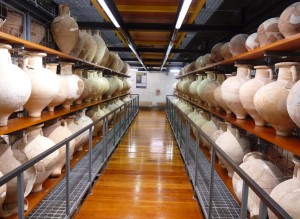 f’dawk l-inħawi. Affarijiet oħra li ttellgħu mill-bajja ta’ Camarina kienu jiffurmaw parti mit-tagħbija kummerċjali ta’ bosta xwieni li għerqu fil-post: prova tal-kummerċ kbir li kien isir f’dawk l-inħawi f’perjodi mbiegħda. Dawk l-aktar spettakolari jinkludu żewġ elmi tal-gwerra, numru ta’ statwetti u għodod, u kwantità ta’ msiebaħ u oġġetti tal-fidda.Huwa fatt magħruf li din il-bajja ta’ Camarina dan l-aħħar saret famuża mat-turisti minħabba s-serje popolari televiżiva ‘Il Commissario Montalbano’ peress li diversi xeni nġibdu f’dawn l-inħawi. Min-naħa l-oħra aktarx ftit jafu li f’din il-bajja jinstabu regolarment oġġetti arkeoloġiċi – bħas-6000 munita antika li nqalgħu minn taħt ir-ramel wara tempesta qalila li seħħet fl-1991.
f’dawk l-inħawi. Affarijiet oħra li ttellgħu mill-bajja ta’ Camarina kienu jiffurmaw parti mit-tagħbija kummerċjali ta’ bosta xwieni li għerqu fil-post: prova tal-kummerċ kbir li kien isir f’dawk l-inħawi f’perjodi mbiegħda. Dawk l-aktar spettakolari jinkludu żewġ elmi tal-gwerra, numru ta’ statwetti u għodod, u kwantità ta’ msiebaħ u oġġetti tal-fidda.Huwa fatt magħruf li din il-bajja ta’ Camarina dan l-aħħar saret famuża mat-turisti minħabba s-serje popolari televiżiva ‘Il Commissario Montalbano’ peress li diversi xeni nġibdu f’dawn l-inħawi. Min-naħa l-oħra aktarx ftit jafu li f’din il-bajja jinstabu regolarment oġġetti arkeoloġiċi – bħas-6000 munita antika li nqalgħu minn taħt ir-ramel wara tempesta qalila li seħħet fl-1991.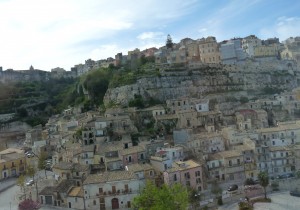 Il-parteċipanti Maltin kienu joqogħdu f’lukanda żgħira ġewwa Ragusa Ibla u minħabba f’hekk huma setgħu jirrikonoxxu kemm dan il-post huwa ideali biex wieħed iqatta’ erbat ijiem hawnhekk sabiex iżur dawn is-siti tal-madwar li tkellimna dwarhom. Ragusa Ibla nnifisha hija belt bi storja kbira. Xhieda ta’ dan huma d-diversi binjiet medjevali u palazzi barokki. Interessanti li wieħed isemmi li ħafna minn dawn il-binjiet kellhom jerġgħu jinbnew wara li parti kbira minn din il-belt ġiet meqruda minn terremot qawwi li seħħ fil-11 ta’ Jannar 1693, fejn anki mietu madwar 5000 persuna. Wara din id-diżgrazzja wħud mill-abitanti riedu jerġgħu jibnu l-belt fejn kienet oriġinarjament, filwaqt li oħrajn għażlu nħawi aktar fl-għoli biex jibnu r-residenza tagħhom. Infatti llum tliet pontijiet jgħaqqdu l-parti tal-belt l-antika mal-parti l-ġdida. Ragusa Ibla, bil-bini tagħha antik donnu mdendel mal-blat tal-irdumijiet u mgezzez f’xulxin, joffri dehra tassew spettakolari. Mhux ta’ b’xejn li l-post ġibed lejh bosta fotografi u anki kumpaniji tal-films.
Il-parteċipanti Maltin kienu joqogħdu f’lukanda żgħira ġewwa Ragusa Ibla u minħabba f’hekk huma setgħu jirrikonoxxu kemm dan il-post huwa ideali biex wieħed iqatta’ erbat ijiem hawnhekk sabiex iżur dawn is-siti tal-madwar li tkellimna dwarhom. Ragusa Ibla nnifisha hija belt bi storja kbira. Xhieda ta’ dan huma d-diversi binjiet medjevali u palazzi barokki. Interessanti li wieħed isemmi li ħafna minn dawn il-binjiet kellhom jerġgħu jinbnew wara li parti kbira minn din il-belt ġiet meqruda minn terremot qawwi li seħħ fil-11 ta’ Jannar 1693, fejn anki mietu madwar 5000 persuna. Wara din id-diżgrazzja wħud mill-abitanti riedu jerġgħu jibnu l-belt fejn kienet oriġinarjament, filwaqt li oħrajn għażlu nħawi aktar fl-għoli biex jibnu r-residenza tagħhom. Infatti llum tliet pontijiet jgħaqqdu l-parti tal-belt l-antika mal-parti l-ġdida. Ragusa Ibla, bil-bini tagħha antik donnu mdendel mal-blat tal-irdumijiet u mgezzez f’xulxin, joffri dehra tassew spettakolari. Mhux ta’ b’xejn li l-post ġibed lejh bosta fotografi u anki kumpaniji tal-films.Il-proġett Archaeotur huwa mistenni li jħeġġeġ aktar turiżmu kulturali bejn Ragusa u Malta, fosthom billi jinforma lill-pubbliku bl-opportunità li wieħed iżur dawn is-siti fiż-żewġ gżejjer. L-istorja ta’ Sqallija u ta’ Malta sikwit twaħħdet u mhux darba u tnejn li dawn il-popli, għalkemm mifrudin b’firxa wiesgħa ta’ baħar, għexu esperjenzi konnessi ma’ ta’ xulxin.
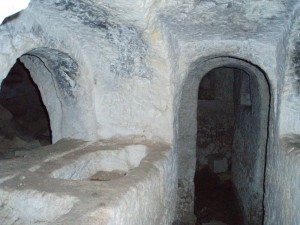 Għas-seminars ta’ Archaeotur li ser jiġu organizzati f’Malta, ser jattendu wkoll diversi esperti, studenti u individwi minn Sqallija ħalli b’hekk terġa’ tingħata l-opportunità għat-taħlit tal-ideat u għad-diskussjoni dwar ix-xogħol li għad fadal isir kemm fis-siti ta’ Malta u kif ukoll dawk ta’ Sqallija, sabiex b’hekk jistagħna l-patrimonju kulturali taż-żewġ gżejjer. Fuq kollox il-parteċipanti ser ikunu qed jiġu mdawwra ma’ xi siti arkeoloġiċi Maltin bħall-katakombi Ta’ Bistra fil-Mosta u dak ta’ Santu Wistin fir-Rabat, li s’issa qatt ma kienu miftuħa għall-pubbliku.
Għas-seminars ta’ Archaeotur li ser jiġu organizzati f’Malta, ser jattendu wkoll diversi esperti, studenti u individwi minn Sqallija ħalli b’hekk terġa’ tingħata l-opportunità għat-taħlit tal-ideat u għad-diskussjoni dwar ix-xogħol li għad fadal isir kemm fis-siti ta’ Malta u kif ukoll dawk ta’ Sqallija, sabiex b’hekk jistagħna l-patrimonju kulturali taż-żewġ gżejjer. Fuq kollox il-parteċipanti ser ikunu qed jiġu mdawwra ma’ xi siti arkeoloġiċi Maltin bħall-katakombi Ta’ Bistra fil-Mosta u dak ta’ Santu Wistin fir-Rabat, li s’issa qatt ma kienu miftuħa għall-pubbliku.Aktar informazzjoni dwar il-proġett Archaeotur tista’ tinkiseb mill-website www.archaeotur.eu. Reġistrazzjonijiet għall-attendenza f’dan is-seminar jistgħu jsiru kemm permezz tal-istess sit elettroniku, inkella billi tintbagħat e-mail lill-Kuratur tal-Proġett, Glen Farrugia, fuq glen.farrugia@gov.mt
(Nota: Dan l-artiklu ġie ppubblikat fit-Torċa tas-26 t’Awwissu 2012)
-
PART OF THE FAMILY – pdf version
It is hard not to see a soul in the earnest eyes of a faithful animal, and it is this very entity that the intricate and colourful brush strokes of pet artist GAYNOR HUNT seek to portray …
Part of the Family – Part 1
Part of the Family – Part 2This article was published on First Magazine issued with The Malta Independent on Sunday of the 12th August 2012.
-
PART OF THE FAMILY
It is hard not to see a soul in the earnest eyes of a faithful animal, and it is this very entity that the intricate and colourful brush strokes of pet artist Gaynor Hunt seek to portray.
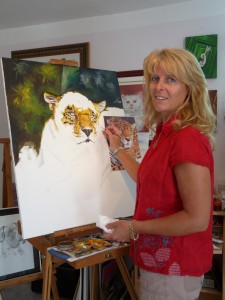 Most pets have a significant meaning in people’s lives. Their loyal companionship at times tends to excel even the presence of other humans. Indeed, many owners regard them as part of one’s family, whilst for some individuals who find themselves alone, a pet becomes the family. Pets give people joy, friendship, support and love. Ultimately their loss could prove to be quite painful.
Most pets have a significant meaning in people’s lives. Their loyal companionship at times tends to excel even the presence of other humans. Indeed, many owners regard them as part of one’s family, whilst for some individuals who find themselves alone, a pet becomes the family. Pets give people joy, friendship, support and love. Ultimately their loss could prove to be quite painful.“When my brother’s labrador died he missed it terribly and to comfort him, his partner commissioned a portrait of it. My brother was delighted with this gift and during that moment I understood the value of such work and decided instantly that one day, that would be my job.”
Quite artistic from childhood, Gaynor was further encouraged by her father when he involved her in the restoration of antique vehicles and machines.
“Around the farm where we lived in Derbyshire, England, there was an extensive stretch of land which my father allotted for a number of ancient vehicles that he intended to restore. There were all sorts of objects such as trucks, small steam trains, carousels and even an old Maltese bus. I used to help him restore their painting and this eventually led me to work as a sign-writer artist. Subsequently, my father succeeded to transform this land into a museum.”
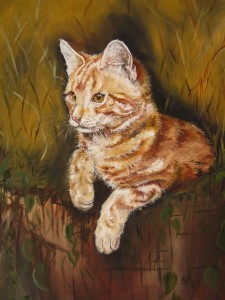 When Gaynor met her partner she had to let go of her painting since they needed to travel frequently. However in these last years they have settled in Malta and finally Gaynor found the time to fulfill her dream.
When Gaynor met her partner she had to let go of her painting since they needed to travel frequently. However in these last years they have settled in Malta and finally Gaynor found the time to fulfill her dream.“I find Malta’s picturesque scenery deeply inspiring for my artworks. Now I have my studio where I can work at my leisure and relish the feeling of being surrounded by my creations.”
Gaynor’s studio is delightful, comfortable and bright. The vision and smell of the various oil colours lying neatly at one’s reach are enticing. I found her working on the painting of a leopard. Somehow animals are her preferred subject…
“I find animals extremely fascinating to paint, much more than humans. Probably because they are so varied and beautiful. While I’m painting them I actually feel the sensation of their presence: their wet noses, their velvety long or short fur, their strong bones or their delicate structure. It’s difficult to explain… it’s a strange and lovely sentiment. Inevitably this passion was born in me during my childhood years when I lived on the farm.”
Paintings of domestic and wild animals were displayed around Gaynor’s studio. However, a painting of a boxer dog seemed to stand in a prominent spot.
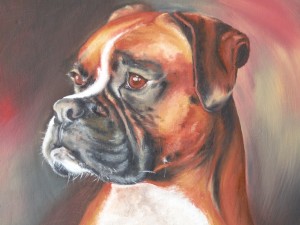 “That is my favourite painting. It shows my dog, Rocky. I missed him intensely when he passed away but when I finally completed his painting, I regained a sense of comfort since now I feel him beside me whenever I look at his image. The painting shows him exactly as I remember him: smart, proud and playful.”
“That is my favourite painting. It shows my dog, Rocky. I missed him intensely when he passed away but when I finally completed his painting, I regained a sense of comfort since now I feel him beside me whenever I look at his image. The painting shows him exactly as I remember him: smart, proud and playful.”Though a common tradition in England, pet portaiture is not characteristic in Maltese culture.
“I find this quite strange because I notice that Maltese people are very fond of their pets. Presumably it is because they are not aware of the availability of pet artists. A painting of one’s pet is a way of eternalizing its memories. It is a distinguished symbol of the deep love that can exist between humans and their animals.”
For more information Gaynor Hunt can be contacted on email gaynorhunt@live.co.uk or mobile 99809445.
(An edited version of this article was published in FIRST magazine that was issued with The Malta Independent on Sunday on 12 August 2012. A pdf version of the published feature is also available under the title PART OF THE FAMILY).
-
ICH LIEBE MALTA
 A little train set ignited a passion for model building in a young boy of three…. Now forty, Rainer Mader reveals that the same passion has kindled an intense fascination for Malta and its culture, its history and its people.
A little train set ignited a passion for model building in a young boy of three…. Now forty, Rainer Mader reveals that the same passion has kindled an intense fascination for Malta and its culture, its history and its people.“It was Christmas and my parents gave me a wonderful model train set which consisted of a black locomotive with three green passenger cars and two other red cars. These model rail sets are very popular in Germany, especially with young children who are delighted and intrigued by the movement of the trains going round on the rails. However, these train sets are also a favourite with adults too who build large landscapes through which the trains can move. Eventually it can prove to be quite an expensive hobby.”
Sitting in the cosy lounge of Preluna hotel, Rainer explained how he ended up getting hooked on this hobby of model building.
 “I never stopped building models from then on, but when I joined the army, my interest turned onto military modeling. I prefer tanks, trucks and jeeps which I purchase as semi-assembled models. My finished models are around 10 cms and usually I finish them within one day. The most laborious work is the painting, as these models require to have a weathered used look and they actually need a lot of drying time.”
“I never stopped building models from then on, but when I joined the army, my interest turned onto military modeling. I prefer tanks, trucks and jeeps which I purchase as semi-assembled models. My finished models are around 10 cms and usually I finish them within one day. The most laborious work is the painting, as these models require to have a weathered used look and they actually need a lot of drying time.”Rainer admits that he has a rather impatient nature and that once he begins to work on a model, he would want to finish it as soon as possible.
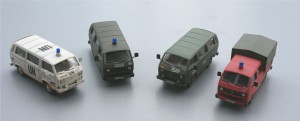 “I love this hobby because it gives me a rest from my work. Yet being very busy, I don’t have much time available to spend on a model and therefore I choose to work on semi-assembled ones. Nonetheless there are moments when I opt to convert a standard model in order to build a particular one which is not yet on the market. For example, we still have some special American trucks in Germany which are presently changing all the equipment with brand new staff. Now usually that would take about two to four years for the industry to provide an exact model of the new vehicle. So my aim would be to find a similar model of that truck and modify it accordingly in order to possess a small version of the new vehicle beforehand”.
“I love this hobby because it gives me a rest from my work. Yet being very busy, I don’t have much time available to spend on a model and therefore I choose to work on semi-assembled ones. Nonetheless there are moments when I opt to convert a standard model in order to build a particular one which is not yet on the market. For example, we still have some special American trucks in Germany which are presently changing all the equipment with brand new staff. Now usually that would take about two to four years for the industry to provide an exact model of the new vehicle. So my aim would be to find a similar model of that truck and modify it accordingly in order to possess a small version of the new vehicle beforehand”.His first glimpse of Malta back in 1999 was love at first sight…..
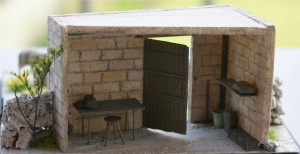 “Malta is totally different from where I live in Aschaffenburg, near Frankfurt in Germany. I remember that what impressed me most was the proximity of the sea. I love the sea… it’s beautiful crystal blue colour, it’s salty smell, and it’s ever changing sounds. It gives me a very pleasant feeling to hear it, smell it and see it everywhere around me here in Malta.”
“Malta is totally different from where I live in Aschaffenburg, near Frankfurt in Germany. I remember that what impressed me most was the proximity of the sea. I love the sea… it’s beautiful crystal blue colour, it’s salty smell, and it’s ever changing sounds. It gives me a very pleasant feeling to hear it, smell it and see it everywhere around me here in Malta.”His sister introduced him to some of her Maltese friends from Santa Venera and from then on, a long friendship was born where Rainer got to know better the Maltese people and their culture. His interest in Malta continued to grow even further once he discovered the local Association of Model Engineers and became a member there.
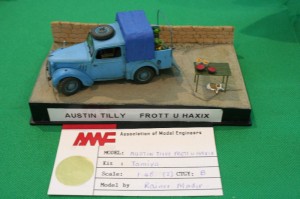 “The Association organizes an annual model exhibition and in these last five years, I have always participated with my models. Thanks to the AME I met many model enthusiasts and soon we became good friends. One can say that these exhibitions serve as a showcase of our hobby while at the same time they provide an opportunity to introduce and blend different cultures together. For example through these model exhibitions, the Maltese can experience a railway, whilst foreigners can get to know about some local customs.”
“The Association organizes an annual model exhibition and in these last five years, I have always participated with my models. Thanks to the AME I met many model enthusiasts and soon we became good friends. One can say that these exhibitions serve as a showcase of our hobby while at the same time they provide an opportunity to introduce and blend different cultures together. For example through these model exhibitions, the Maltese can experience a railway, whilst foreigners can get to know about some local customs.”In fact Rainer decided to surprise his Maltese friends by building diaromas which depict the local history and landscape.
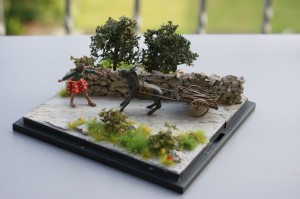 “Last year, I was flipping through the pages of a tourist magazine about Malta when I saw some old photos which instilled in me the desire to give them life through my diaromas. My first diaroma represented a van which sold vegetables and fruit. This year I made another two: one showing a woman trying to pull behind her an unwilling donkey, and another one which illustrates a sheperd with his sheep in his farm. These models were very much appreciated during the exhibition and in fact I won a gold medal”.
“Last year, I was flipping through the pages of a tourist magazine about Malta when I saw some old photos which instilled in me the desire to give them life through my diaromas. My first diaroma represented a van which sold vegetables and fruit. This year I made another two: one showing a woman trying to pull behind her an unwilling donkey, and another one which illustrates a sheperd with his sheep in his farm. These models were very much appreciated during the exhibition and in fact I won a gold medal”.Proudly Rainer showed me his dioramas while he tried to describe them in the Maltese language. Being a typical romantic Maltese, I could not help not appreciating this German’s effort to try to speak our language.
 “I realized that once you start to learn some Maltese, you will increase the possibility of making friends faster. My Maltese friends simply love hearing me speak their language and many of them try to teach me some new words. In fact, a friend of mine who works as a printer, has even printed a dictionary for me with German and Maltese words and the German phonetic way to say them in Maltese. I also bought some books which include CDs of Maltese words in order to learn better the language. By now, I can only speak basic words and sentences but I am adamant to learn more. At times, I find a Maltese word which I do not understand and I ask my Maltese friends to explain to me what it means. Then, each time that I visit again, I love to surprise them with some new expressions that I learn.”
“I realized that once you start to learn some Maltese, you will increase the possibility of making friends faster. My Maltese friends simply love hearing me speak their language and many of them try to teach me some new words. In fact, a friend of mine who works as a printer, has even printed a dictionary for me with German and Maltese words and the German phonetic way to say them in Maltese. I also bought some books which include CDs of Maltese words in order to learn better the language. By now, I can only speak basic words and sentences but I am adamant to learn more. At times, I find a Maltese word which I do not understand and I ask my Maltese friends to explain to me what it means. Then, each time that I visit again, I love to surprise them with some new expressions that I learn.”Cheerfully, Rainer admitted that he is also enthralled by the local food and drink. I was quite amazed when he listed the amount of cans of Cisk and Kinnie, and packets of galletti and Twistees that he takes back with him to Germany to enjoy with his friends. Thinking about it, I thought that maybe each time that he returns back to Germany, Rainer is trying to take a little part of Malta with him.
 “It is true! I came to love Malta and its people very much. In fact from 2003, I visit this island each year, my visits getting more frequent each time, so that now I come to Malta three times a year. Moreover, I have a little calendar at my place of work and while I am waiting for the machines to finish, I just flip its pages and have a look. When I exhibited last year’s diorama in a German exhibition, people were very curious about it and they asked me from where I got the idea for that landscape. So I explained to them about Malta and I showed them some books about the island. Somehow these dioramas are very special to me and I won’t part with them for anything else.”
“It is true! I came to love Malta and its people very much. In fact from 2003, I visit this island each year, my visits getting more frequent each time, so that now I come to Malta three times a year. Moreover, I have a little calendar at my place of work and while I am waiting for the machines to finish, I just flip its pages and have a look. When I exhibited last year’s diorama in a German exhibition, people were very curious about it and they asked me from where I got the idea for that landscape. So I explained to them about Malta and I showed them some books about the island. Somehow these dioramas are very special to me and I won’t part with them for anything else.”Naturally Rainer is very fond of the local villages which are most near to the sea like Dingli and Xlendi. He strongly resists the idea of a bridge from Malta to Gozo because he claims that it would surely ruin the scenery. He doesn’t like the modern Maltese architecture especially the never-ending apartments which are replacing, according to him, the lovely old houses such as those that up to some years ago, used to be on the Sliema seafront. Moreover he feels perplexed about the permits of huge establishments with not enough parking space inside.
“When you visit a country so regularly, you tend to become involved more closely to it and to its people. Actually I am also very interested in the local history especially from 1940 till now, particularly the Second World War period.”
At this point, I could not help asking…. Being a German who has Malta at heart so much, how does it feel to get to know about the participation of the Germans in this war in relation to our islands?
 “Surely I am not proud of this history but no one can do anything about it; that was war and thankfully it’s history! I do feel touched when I visit the Malta at War Museum and I see those underground shelters. However though grim and painful, I need to face this history as it also gives me more background for this hobby in model making. Certainly the merging together of different cultures through such activities will help people to relate better to each other, and to establish mutual bonding and respect that will prevent history from ever repeating itself.”
“Surely I am not proud of this history but no one can do anything about it; that was war and thankfully it’s history! I do feel touched when I visit the Malta at War Museum and I see those underground shelters. However though grim and painful, I need to face this history as it also gives me more background for this hobby in model making. Certainly the merging together of different cultures through such activities will help people to relate better to each other, and to establish mutual bonding and respect that will prevent history from ever repeating itself.”Rainer gave me the impression that by now his life is divided between two countries. In fact, he came to celebrate his 40th birthday with a very long holiday among his Maltese friends. Curiously I asked him whether he would ever consider to come and live for good in Malta?
“Għalissa għadha ħolma…. For now it’s only a dream. But probably, when I’ll come to retire from work, this possibility will be very much on my mind. Presently I can only foretell my next visit to Malta in October wherein I intend to present some new dioramas. But that is all I can say… the rest is a secret!”
(Note: An edited version of this article was published on FIRST magazine Issue June 2012).
-
MINIATURE CHURCH DEVOTION
As several bombs were let loose on our islands during the attacks of World War II, their destructive effects threatened more than human lives and buildings. They put at peril our heritage, jeopardizing the roots of our people and the future of our country.
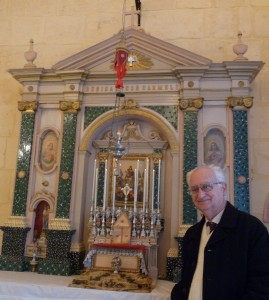 Raphael Micallef, now 82, still recalls the terror felt by the people as the shrill of the air-raid sirens urged them to leave their houses and run for shelters. As an inhabitant of the capital city, he saw his town being shattered to pieces, the damage claiming even unique treasures such as the Chapel of Bones which used to be so popular both with the locals and the tourists. People huddled together in shelters and prayed for their own safety but they also implored for their houses to be spared as these nested within them all their possessions, memories of loved ones, and valuable objects which had been passed on from generation to generation.
Raphael Micallef, now 82, still recalls the terror felt by the people as the shrill of the air-raid sirens urged them to leave their houses and run for shelters. As an inhabitant of the capital city, he saw his town being shattered to pieces, the damage claiming even unique treasures such as the Chapel of Bones which used to be so popular both with the locals and the tourists. People huddled together in shelters and prayed for their own safety but they also implored for their houses to be spared as these nested within them all their possessions, memories of loved ones, and valuable objects which had been passed on from generation to generation.“Valletta and Cottonera suffered some of the severest attacks. Unfortunately within these areas one could find the best examples of church models, many of which had been inherited over many years. Sadly most of them had to be abandoned during the war and almost all of them ended up buried under the rubble of destroyed buildings.”
The craft of church model-making had been introduced to our islands by the Knights of St John back in the 16th century, and therefore it’s knowledge was a distinct tradition. However the adversity of war ravaged even this ancient memory until eventually this craft was almost completely forgotten.
In 1986, this dire situation inspired Raphael, who was an avid enthusiast in church model-making, to make an effort to revive this craft. Together with his friends Tony Terribile and Paul Piscopo, he ventured to initiate an association under the name of Għaqda Dilettanti Mudelli ta’ Knejjes which aimed to instill interest, knowhow and craftsmanship in the art of church model-making. The first president of the association was Guido Lanfranco.
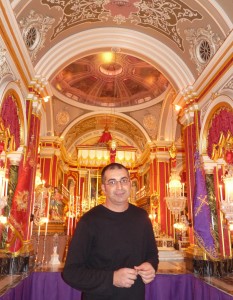 “After 26 years, I am proud to say that now we have our own premises at 37 East Street, Valletta. Although it is a small place, our 400 members meet keenly under its humble roof in order to attend to the regular activities that we organize. Members’ ages differ greatly; starting from young children of 7 and going up to elderly individuals over 90. Everybody is welcome in our group and together we learn and discuss new ideas of how to enrich this cultural tradition. Each of the members has the opportunity to explore his skills and to enhance them further both through the interaction with other members and also under the guidance of craftsmen and historians who are frequently invited to our premises. Many members have built their own church models, some of which one can even walk through – a popular model is that of Simon Mercieca which is often open to the public for viewing. Others have opted to produce statues and accessories which are used in the church models. Most of the members succeed in producing marvellous works, sometimes using common objects and transforming them into intricate decorations which adorne the models.”
“After 26 years, I am proud to say that now we have our own premises at 37 East Street, Valletta. Although it is a small place, our 400 members meet keenly under its humble roof in order to attend to the regular activities that we organize. Members’ ages differ greatly; starting from young children of 7 and going up to elderly individuals over 90. Everybody is welcome in our group and together we learn and discuss new ideas of how to enrich this cultural tradition. Each of the members has the opportunity to explore his skills and to enhance them further both through the interaction with other members and also under the guidance of craftsmen and historians who are frequently invited to our premises. Many members have built their own church models, some of which one can even walk through – a popular model is that of Simon Mercieca which is often open to the public for viewing. Others have opted to produce statues and accessories which are used in the church models. Most of the members succeed in producing marvellous works, sometimes using common objects and transforming them into intricate decorations which adorne the models.”Each year, during the Lenten period, the association organizes an exhibition with some of the works of the members, both to give them the opportunity to share their skill with others and also to attract the public to this old tradition.
“Our association is deeply cherished by its members. In fact some of them have honoured us by donating us prestigious works which belonged to them or to their families. It is a great privilege to possess a number of the few lucky survivors of war which managed to make it, as their owners lovingly took them along with them to safer areas.”
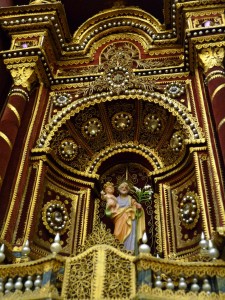 Raphael showed me some of these examples, including an elegant limestone church facade which was designed by Manuel Psaila between 1935 and 1940, and a delicate niche produced out of quilling which dates back to more than 100 years. I was thankful to Raphael for having shared with me this experience. His calm and serene smile was full of pride as his dream of giving the life back to a part of our culture was fulfilled. In fact the association’s work has succeeded to reach much further grounds than any of the members could ever have aspired for, when in 1994, Joseph Sciberras ended up winning a place in the Guinness Book of Records for his church model which was made out of more than 3 million used up matchsticks!
Raphael showed me some of these examples, including an elegant limestone church facade which was designed by Manuel Psaila between 1935 and 1940, and a delicate niche produced out of quilling which dates back to more than 100 years. I was thankful to Raphael for having shared with me this experience. His calm and serene smile was full of pride as his dream of giving the life back to a part of our culture was fulfilled. In fact the association’s work has succeeded to reach much further grounds than any of the members could ever have aspired for, when in 1994, Joseph Sciberras ended up winning a place in the Guinness Book of Records for his church model which was made out of more than 3 million used up matchsticks!I met Joseph Sciberras, now 93, in his son’s home in Attard. Sitting cosily near his bird pet who sung cheerfully at his side, Joseph told me the story of his model which has given him so much satisfaction in his life.
“I was an electrician by trade but during the war I was engaged as a soldier. I remember vividly a particular day when I was at work in Delimara and came to know that Floriana, where I lived, had just been badly hit by bomb attacks. I was desperate to see whether my family was safe and whether our house was damaged, and my superior allowed me to leave. I walked right back to Floriana there and then, and luckily both my family and my house were safe. The enemy used to target his attacks from the Floriana parish church and bomb throughout. We lived nearby and one day our house did fall victim to these attacks, alas like the church which did too anyway.
 Years passed and both our houses and the Floriana parish church were rebuilt. I used to like to observe the facade of our beloved church and when I became a pensioner, I decided to start building an exact model of it. I chose to construct it out of used up matchsticks. Day after day, I worked on my model, constantly taking measures and designing the acute details of the facade.
Years passed and both our houses and the Floriana parish church were rebuilt. I used to like to observe the facade of our beloved church and when I became a pensioner, I decided to start building an exact model of it. I chose to construct it out of used up matchsticks. Day after day, I worked on my model, constantly taking measures and designing the acute details of the facade.When my friends who most of them worked at the Dockyards got to know what I was doing, they started to collect used mathsticks for me. Then when I exhibited my first model to the public, these matchsticks began to arrive from different areas of Malta! I had so many in hand that I ended up doing all the parish church inside out, until eventually the model measured 2 metres by 2 metres with a height of a further 1.5 metres.
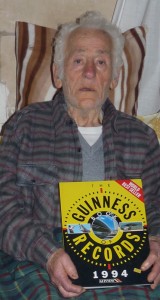 People were totally mesmerized by my model and many, including several tourists, even hugged me when they noticed all the details and work that I had put into my work. It was during one of these exhibitions when some foreigners entered to view my model. I could not be more lucky as these were officials of the Guinness Book of Records and as they studied and measured my model, they informed me that I had succeeded to break the record of the previous winner matchstick model! Soon a certificate arrived together with my inclusion in the Guinness Book of Records.” Spiritedly Joseph showed me his model church displayed on the pages of this famous book. He felt very satisfied that his hard work which took so many years to do was given such an acknowledgement.
People were totally mesmerized by my model and many, including several tourists, even hugged me when they noticed all the details and work that I had put into my work. It was during one of these exhibitions when some foreigners entered to view my model. I could not be more lucky as these were officials of the Guinness Book of Records and as they studied and measured my model, they informed me that I had succeeded to break the record of the previous winner matchstick model! Soon a certificate arrived together with my inclusion in the Guinness Book of Records.” Spiritedly Joseph showed me his model church displayed on the pages of this famous book. He felt very satisfied that his hard work which took so many years to do was given such an acknowledgement.“Ultimately this model became part of my life as I have dedicated much of my love and my time to it. In return it gave me happinness as I saw people admiring it and appreciating my skill and patience. I have taken good care of it all along these years and my final wish is to donate my model to our National Museum of Etnography wherein it could be enjoyed by the public in reminiscence of me and of this ancient cultural tradition. I feel sad to leave it behind me but one cannot live forever, can he?”
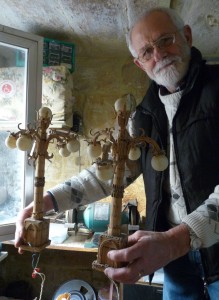 I could not resist the invitation of Francis, Joseph’s son, to visit the workshop of his father in Floriana wherein this model was stored. Humorously Francis indicated the name of the place “Sulfarina” (matchstick). “Interestingly our family was originally known as “Taċ-Ċomb” (of lead) but today, because of my father’s model, everyone knows us as “Tas-Sulfarini” (of the matchsticks). Notwithstanding that my father has stopped working now, I still find packets full of used matchsticks which people leave behind his door.”
I could not resist the invitation of Francis, Joseph’s son, to visit the workshop of his father in Floriana wherein this model was stored. Humorously Francis indicated the name of the place “Sulfarina” (matchstick). “Interestingly our family was originally known as “Taċ-Ċomb” (of lead) but today, because of my father’s model, everyone knows us as “Tas-Sulfarini” (of the matchsticks). Notwithstanding that my father has stopped working now, I still find packets full of used matchsticks which people leave behind his door.”We went into the small building which was totally engulfed by the huge model of the Floriana parish church and by other of Joseph’s works, all made of matchsticks. With some difficulty, Francis managed to find his way through the multitude of wires which his father had included in the model in order to light up the church.
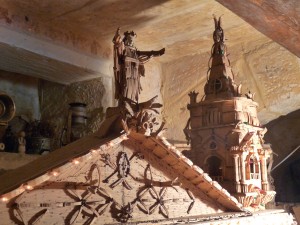 Now I could observe what Joseph had talked about…. the millions of matchsticks, each one placed or thwarted to fit into the shape that he had designed for them…. the facade, the dome, the walls, the columns, the niches, the floor, the minute chairs. There were also small silver apostles which Francis had made for his father to place on the altar. Miniature gorgeous chandeliers made up of common scrap hung beautifully along the flowing arches. It was all set up and ready as if inviting people to go inside.
Now I could observe what Joseph had talked about…. the millions of matchsticks, each one placed or thwarted to fit into the shape that he had designed for them…. the facade, the dome, the walls, the columns, the niches, the floor, the minute chairs. There were also small silver apostles which Francis had made for his father to place on the altar. Miniature gorgeous chandeliers made up of common scrap hung beautifully along the flowing arches. It was all set up and ready as if inviting people to go inside.I gazed inside the model church, my eyes resting and enjoying every detail whilst I slowly understood what this all means… Within this modest model lied the admirable representation of our local skills together with the ability of our people to prevail even through the hardest times.
For further information about the Għaqda Dilettanti Mudelli ta’ Knejjes, one can access their website www.freewebs.com/ghaqda_dilettanti_knejjes or join their facebook page.
(Note: An edited version of this article was published in FIRST magazine Issue April 2012. A pdf version of the published article is available on this website under the title MINIATURE CHURCH DEVOTION).
Travelogue
Archives
| M | T | W | T | F | S | S |
|---|---|---|---|---|---|---|
| « Jan | ||||||
| 1 | 2 | 3 | 4 | 5 | ||
| 6 | 7 | 8 | 9 | 10 | 11 | 12 |
| 13 | 14 | 15 | 16 | 17 | 18 | 19 |
| 20 | 21 | 22 | 23 | 24 | 25 | 26 |
| 27 | 28 | 29 | 30 | 31 | ||
Recent Posts
- A MATTER OF FATE
- MALTA’S PREHISTORIC TREASURES
- THE MAGIC IS IN THE DETAIL
- THE SELLING GAME
- NEVER FORGOTTEN
- Ġrajjiet mhux mitmuma – 35 sena mit-Traġedja tal-Patrol Boat C23
- AN UNEXPECTED VISIT
- THE SISTERS OF THE CRIB
Comments
- Pauline Harkins on Novella – Li kieku stajt!
- admin on IL-KARNIVAL TRAĠIKU TAL-1823
- Albert on IL-KARNIVAL TRAĠIKU TAL-1823
- Martin Ratcliffe on Love in the time of war
- admin on 24 SENA ILU: IT-TRAĠEDJA TAL-PATROL BOAT C23

